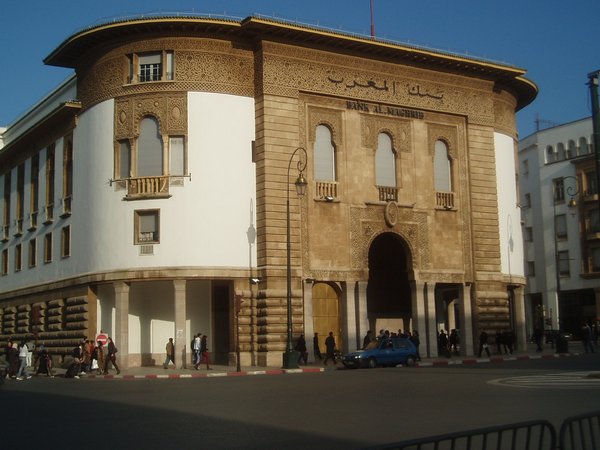
Ancient Arab palace? Nope, a bank they built a few years back
It was never my intent to go to Morocco over spring break. The official plan, though it wasn't much of one two months out, was to drive to New Mexico and go caving in the famed Guadalupe Mountains; I didn't know the first thing about these mountains, or how to find the endless miles of caverns that run through them (I still haven't managed to find half the caves in Gainesville), but I was willing to make a go of it regardless.
Then one day it appeared; I'm not sure how, as it wasn't advertised in any email or website, but through some random sequence of events, the ticket pulled itself onto my screen. The idea of going overseas for a one-week break had always struck me as a bit ludicrous - to spend hundreds or thousands of dollars and live in planes and airports for several days, only to stay a meager seven days in-country would seem the game of a spendthrift and a sadist. But nevertheless, when I saw that I could get from Gainesville to Madrid for $500 and to Casablanca for only $60 more, I had no choice; it was as if I had been commanded to make this humorously brief journey across an ocean and three continents, and no measure of common sense or half-baked caving plans could stand in my way.
Andie, still dazed from our whirlwind foray into Central America, and quite convinced that she would have some sort of school work to do over break, was not as quick to realize the beauty of this $560 dream ticket. She hedged for 36 hours, while the two last perfect tickets sat, precariously perched, free for any yahoo to sign on and grab. I had no choice but to buy mine, hoping that this gesture would shake her into action, but it failed in this regard, and thus we would be spending our break several thousand miles apart.
I set out at dawn Friday morning to bike the 7.5 miles to Gainesville Regional. My friend had any early morning class and had offered to drive me, but I knew when I bought the ticket that, no matter the weather, the bike ride was a very necessary and significant step. Every other international trip I'd taken had begun with the Herculean tasks of finding a ride, arranging a place to stay the night before, and/or ferreting out a free long-term parking place. This time around, none of that was needed; I just had to get on my bike and ride - one final bit of exercise before 25 hours of stale air and security announcements.
I pulled up to an empty rack and locked my bike up 30ft from the check-in desk. I was the only passenger at 7:30; several more would show up half an hour shy of the 11am departure. The Gainesville airport still hasn't gotten its requisite Starbucks; its single room is instead equipped with 2 vending machines and an Independent Florida Alligator box.
An hour-long flight would deposit me in Charlotte. I had never thought much of the city, viewing it as something of a country hub, a commerce link for the Triangle and mountain towns to the west. This may very well be the case, but to see its airport, you would think you had arrived in one of the greatest cities on earth. Sprawling across 5 concourses, with gelati shops and shoe shiners, barbecue joints and Bojangles, and an attendant in every bathroom to give you a mint and paper towel, Charlotte Douglas International exudes a cosmopolitan majesty.
A five-hour layover, an hour ride to Philly, and another layover would finally bring me to the international leg. USAirways has yet to scrap its free beverage and food services, but though we were flying on a Friday night in Lent to a predominantly Catholic country, the only dish on order was beef brisket. The headphones were $5, so I chose to watch the recent one-week-to-dvd Max Payne, which I assumed would be more enjoyable without the dialogue.
The final leg of the trip was of some concern; since it was a separate booking, and on a zero-service deep discount carrier at that, I would only be going to Morocco if the Madrid-bound plane landed within 2 hours of its scheduled arrival time. I had fully prepared myself for the very real possibility of spending the week in Spain. As it happened, we arrived ahead of schedule and I had a 3-hour wait til my final flight.
We arrived just after 2 and I cleared customs just in time to grab the 3'oclock train to Rabat. The trains here are all imported from France; the Moroccans have changed the logo, and slapped on a few extra layers of grime, and done away with that annoying announcement system that keeps you apprised of where you are and where you're going, but these are otherwise the same cars you might have ridden on the opposite side of the straits half a century ago.
Distinct from many cities around the world, the Rabat train station delivers you not to a dingy ghetto, but to a grand, palm-lined boulevard that takes you through the ville nouvelle, with its monumental banks and government offices, and delivers you through the ancient walls, straight to the heart of the old city. The medina is a maze-like array of streets filled with shoes, carpets, animal carcasses, fruits, lamps and every other conceivable good. The amount of street food is staggering; lines of restaurants sell the typical couscous and tajines for bargain prices, but beyond those are carts selling pralines, pastries, chocolates, roasted chestnuts, chickpeas, and nutella-coated pancakes (just to name a few). Naturally, I passed up all of these mouth-watering treats, and selected as my first culinary experience of the trip, the snail cart. Fifty cents bought me all the snails I could eat, which turned out to be right around 4; these were not your typical succulent, butter-soaked French-style escargot - these snails tasted like dirt and old dish water; I ended with one that had the size and appearance of a giant west coast banana slug - a quick word to the wise: avoid the big ones.
At the edge of the medina, the kasbah's ramparts dropped dramatically into the sea, and couples strolled along the cobblestone street that lined the walls. Back inland, the Hassan Tower and Mausoleum of Mohammed V made impressive spectacles, with the latter being guarded around the clock by eight costumed guards. I exchanged a series of puzzling looks with one of these guards as I tried to silently ascertain if I were allowed to enter the tomb itself, or if he had in fact been posted there to stop me; when I eventually walked past, he did not raise his ornamental elephant gun in protest, so I could only assume I looked sufficiently Muslim or this was one of the few holy sites open to infidels.
I had expected that, as in Tunisia, the streets would completely empty after sunset and all who would remain would be the hordes of old men quietly sipping tea in the cafes. Quite the contrary, the narrow medina streets filled with throngs of pedestrians so that my relaxed ambling quickly turned to frenetic crowd surfing. On one block I found a series of busy street stalls, each with two roasted, half-stripped cow heads. The procedure here, I soon discovered, was to point to your favorite section of the head, and then the perfectly hued, glistening meat would be scraped off and loaded straight into a pita for you to enjoy. As strange as it sounds, these sandwiches looked absolutely delicious, but I had already exhausted my weird food tolerance with the snails, and I passed these up for a far more mundane cafe serving cheap vegetable tajines.
The bus for Tetouan only took 5 hours, so midnight would be the ideal time to leave to approximate the "overnight" effect, but the bus station was a full 3km from the bustling center and I had no way to buy a ticket or even confirm that there was one without actually going to the station. So I trekked out there around 9 and tried to buy a ticket for later that night; as usual, my French failed me, or the bus agent simply chose not to understand, and I was loaded onto a bus leaving 10 minutes later. I dozed for two hours, but found when I awoke that we had, in search of passengers, actually ended up closer to town than where we'd started. This stall was not enough, however, to prevent us from arriving at the rather inconvenient hour of 3am.

Ancient Arab palace? Nope, a bank they built a few years back
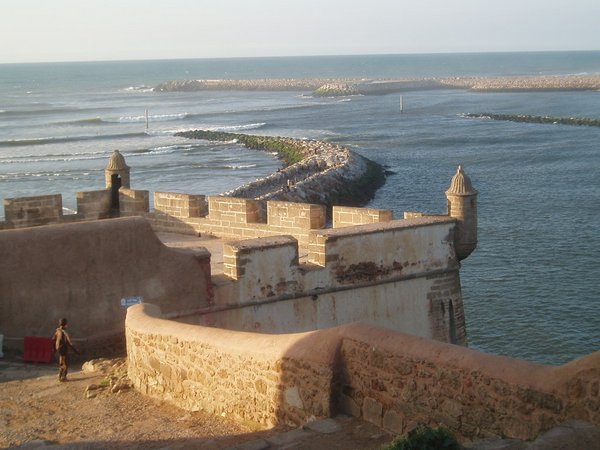
Rabat seaside
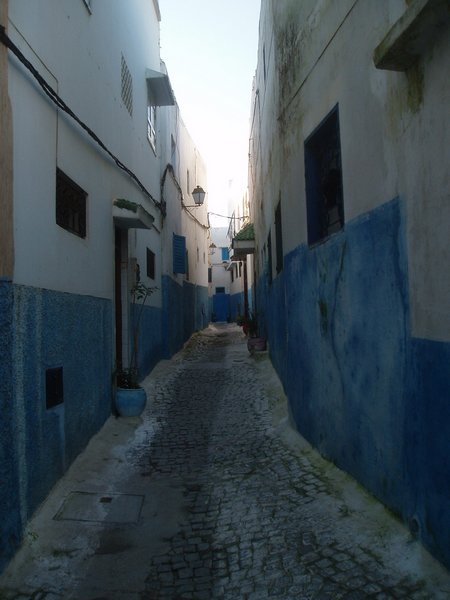
The medina

Lamps and other typical tourist tat

Minaret - note kid doing ninja kick on pedestal

Some famous tomb

The Tetouan station had no chairs, so the fifty-odd people who were waiting there just slept splayed out on the floor; stray cats leapt from one body to the next, looking for handouts or crumbs. One man was intent on molding a friendship with me, regardless of our linguistic differences, and gave me a pudding cup and showed me how to eat it using only the lid. This was all a bit awkward, so I decided to take the next bus to Fnideq on the border with the Spanish colony of Ceuta. This bus was completely packed, save for one seat in the very back row that the other passengers seemed to be going out of their way to avoid; I would discover why shortly after sitting down, as an unidentifiable liquid gradually soaked through the seat of my only pair of pants.
Arriving around 5, I wandered around lost for a bit before finding the seaside promenade bound for the border. The 2km walk was quite scenic, if a bit on the sketchy side. The only other pedestrians I came across were several men with rifles who abruptly popped up next to me from below the cliff edge; after one noted my, he greeted me and shook my hand, but the encounter ended as soon as we discovered we had no shared language between us.
The border was a complicated jumble of incongruous spikes and metal barricades. The Moroccans made me fill out a form and checked my passport multiple times while the Spanish just looked at the American seal on the cover and waved me through without scanning or stamping. Ceuta is a fascinating town with an old fortress, several big churches, and great views of both Morocco and Gibraltar - it's only slightly ruined by Western consumerism. What immediately caught my attention was the preponderance of ads showing women in skimpy underwear, even though most women on the streets never bared so much as an ankle. The Spanish are not known for being early risers, and the town was more or less dead for the hour or so I spent there, so I quickly lost interest and started back toward the border. There was a super convenient bus that ran the 2km stretch to the Spanish side of the fence, but it cost 60 euro-cents, and the driver, reflecting the broader, blindly patriotic attitude of this tiny European outpost, refused to accept dirhams.
There was no line at the Spanish side of the border and the guards barely even acknowledged me as I passed. On the Moroccan side, a considerable queue had formed, but an "official tourist guide" led me to a little shack off to the side where I completed another exit form (they were out of entry forms). At the second checkpoint, the guard gave me a series of questions aimed at deciding whether I intended to eventually return to my home country, or just become a homeless bum in Morocco. It was mildly insulting when I had encountered this sort of interrogation upon crossing into Canada, but the fact that it was deemed necessary for this decidedly third-world country suggested that it might be time for me to wash my clothes.
There are grand Catholic churches throughout the country, but the Moroccans have done a fine job of expunging the faith over the years, and the vast majority of the rapidly decaying buildings now serve as festival halls and gymnasiums. I went to what was quite possibly the last weekly Mass in all of Morocco; it was held in the side chapel of a giant cathedral and had around 25 West African and Spanish ex-pats in attendance.
The Tetouan medina is a UNESCO world heritage sight, and, like other medinas, sells everything you can imagine in a labyrinthine system of alleys. Following the guidebook's map proved useless, and even a compass was of little help, so I settled on the tried-and-true approach of ambling around aimlessly, with no intent of ever finding anything in particular or exiting the maze. I never found restaurant row, but did find a handful of menu-less canteens, none of which were able to convey to me exactly what they served. Upon walking into the first one, the cook handed me a cold, fried squid ring, pinched between his greasy fingers - that grossed me out a bit, so I went next door to where they served hot bowls of chickpea and olive oil soup.
I hopped aboard a collective taxi to Chefchaouen and promptly fell asleep, missing the epic highland scenery as we sped southward into the Rif Mountains. Though my first day in Morocco had been surprisingly tout-free, that reprieve ended the second I stepped into the tourist town's famous blue medina. Each turn would bring me to a new teenager offering up guesthouses, carpets, and the ubiquitous kif (the local, dirt-cheap marijuana that had put this area on the map back in the 60s). I found an excellent small hotel just two signposted turns away from the main square where I got my own room for under 6 bucks - I'm pretty sure the bed was just a flat boulder with a sheet on it, but it still beat the pants off the previous night's non-reclining bus seat.
Just to the east of the medina lay a long series of waterfalls where the whole town's population seemed to be taking their afternoon stroll; another kilometer up a goat path took me to the ruins of an old mosque, where even an infidel like me could climb up the minaret for great views over the valley.
The central square of Chaoen is home to a string of cafes that all serve approximately the same stuff for approximately the same prices. I chose one (much to the chagrin of the tout next door, who verbally accosted my mother for the duration of my meal), and got a 4-course meal (Moroccan salad, chicken tagine, cake, mint tea, banana juice, bread, and olives) for a smidgeon over five bucks. The nightlife was about the same as before - the whole town crowded the streets for no apparent reason - but a series of rolling blackouts made things more fun. The biggest crowds were gathered around the snail carts, though I wasn't quite ready to go down that road again.
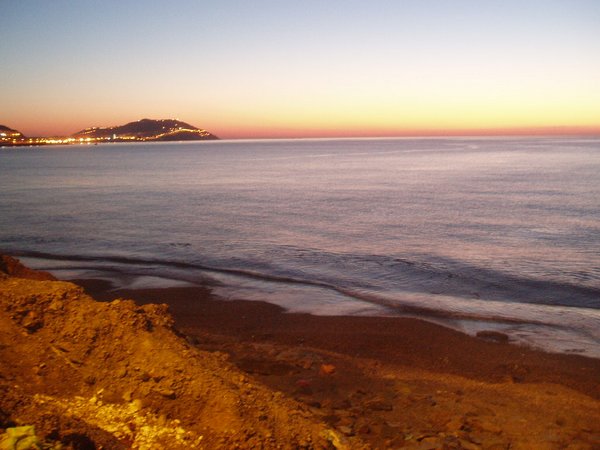
Fnideq at dawn
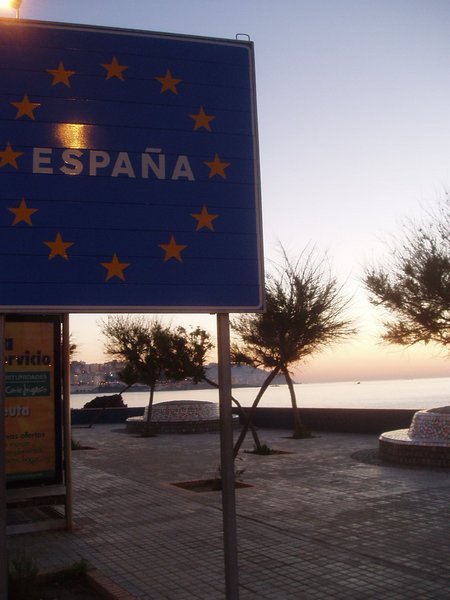
Bet you didn't know you could walk to Spain from Africa, did you?
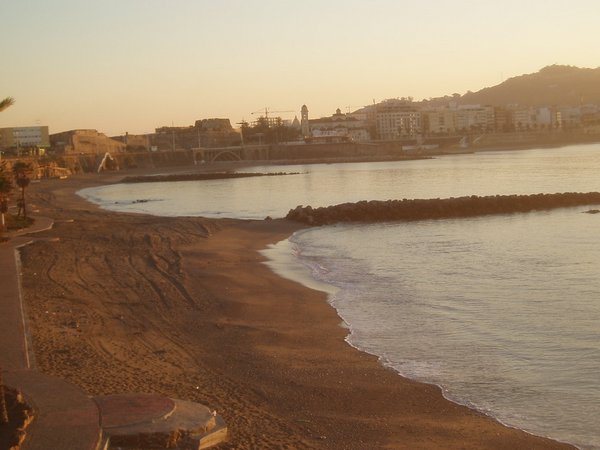
Ceuta
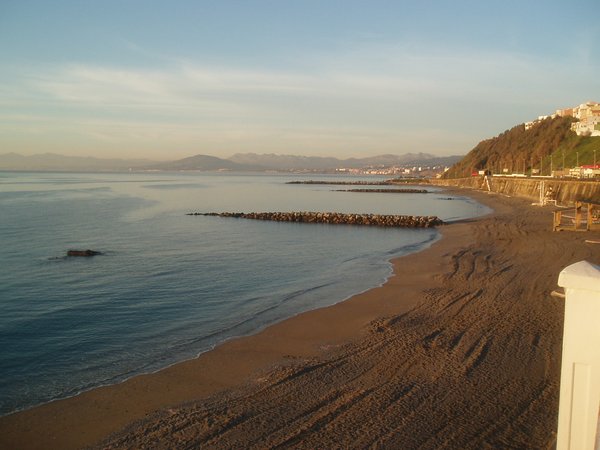
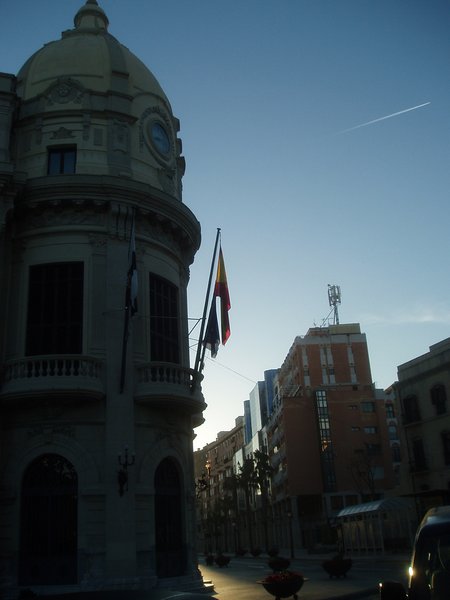

"Ceuta - Keeping the Africans in their place from one generation to the next"
(Disclaimer: This is not really Ceuta's slogan - the costume is worn for one of the Catholic traditions of Semana Santa - the klan stole it from the church)

Dragon house
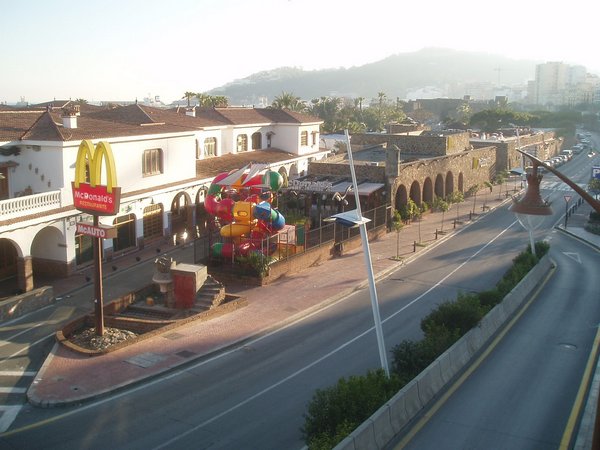
I don't know how I survived the last 24 hours without McDonalds...
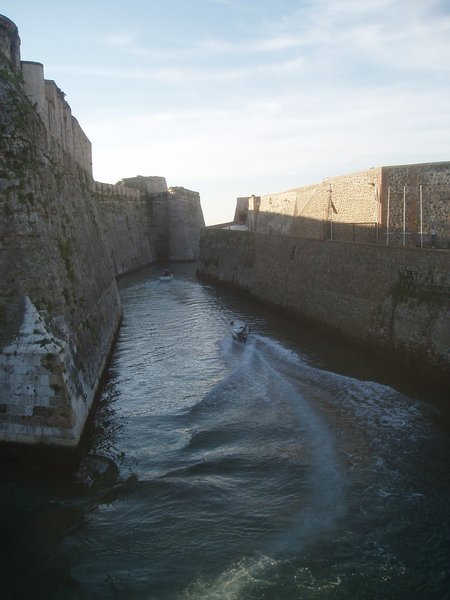
Ceuta fortress
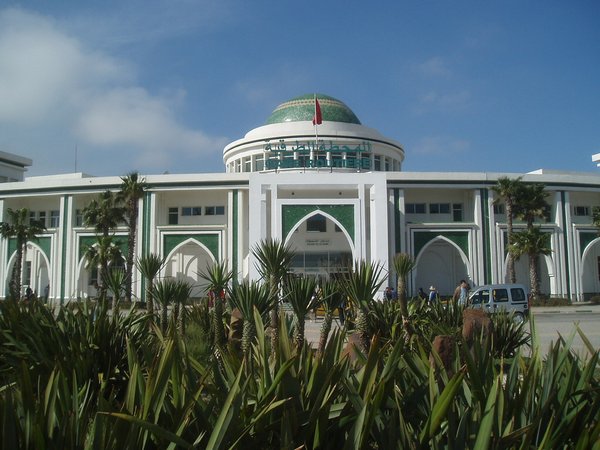
Probably the most attractive building in Tetouan - its bus station
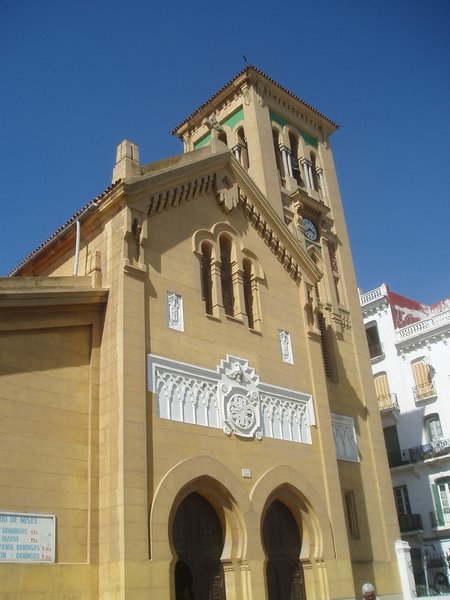
The last operational Catholic church in Morocco
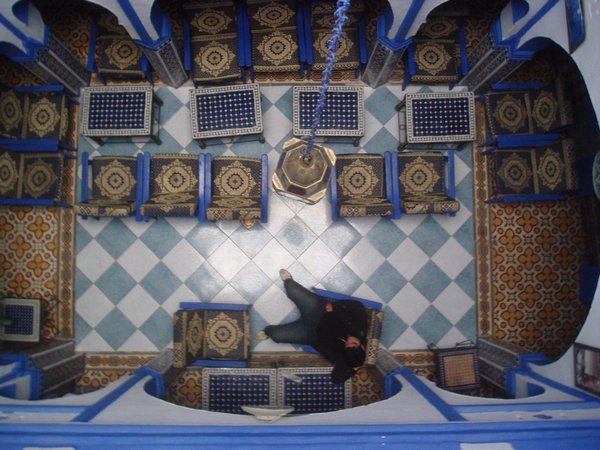
My hotel from above
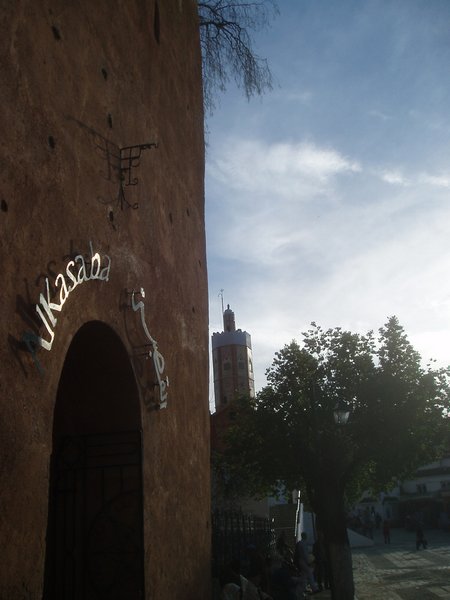
Rock the kasbah!
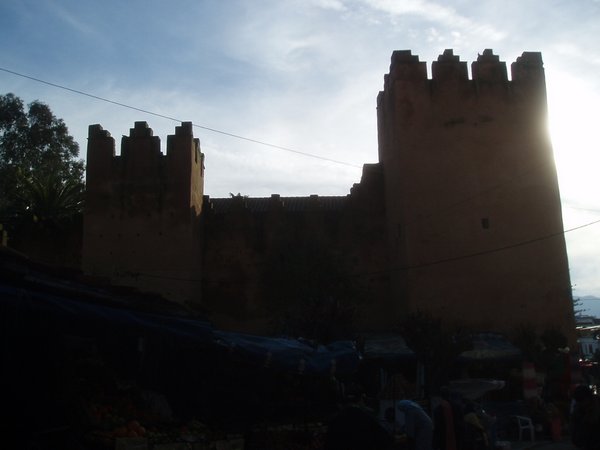
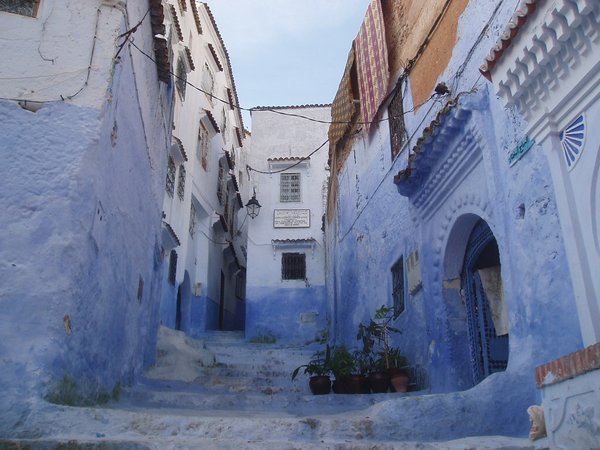

From atop the ruined mosque
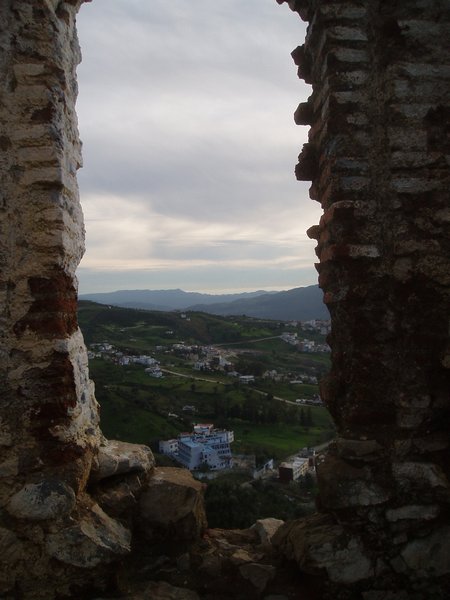
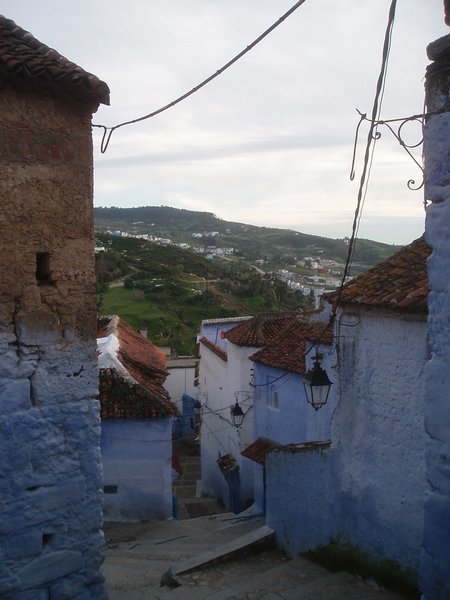
The guidebook had recommended a day hike to a nearby summit and had suggested getting an early start. Since Moroccans by and large don't seem to take to the streets very early, it was a challenge to find someone to let me out of my hotel and subsequently to secure breakfast and a pack lunch, but by 8 I was hiking up a steep trail towards the national park overlooking the town. It was never clear to me whether I took the right trail, as my book had described a pleasant, forested walk with friendly hamlets; the one I did follow rose sharply uphill for several hours without an ounce of shade before it got steeper, and passed a number of gypsy encampments where every resident attempted to sell me weed. From the saddle, the trail to the actual summit was not obvious and seemed to be covered in goats and barking dogs, so I headed down the other side instead and passed along verdant hillsides and quiet villages until the trail dead-ended at the city dump.
The bus station was under construction and only had one bus, which was going in the wrong direction. There were supposedly other buses coming through, but the ticket agent had apparently decided to take a three-hour siesta and there was no way to secure a seat. Walking a mile uphill, I discovered the shared taxi stand seemed to be completely devoid of anyone willing to run a useful route, so I returned to the station and waited til the luxury bus for Fez pulled up. Luckily there were seats, and I found myself next to an interesting fellow who had done his undergrad in Morocco, his Masters in Texas, and his PhD in Spain, before returning to a ski resort outside of Fez to teach English. He told me much of Moroccan ways, including an interesting tidbit about how women in the south frequently use "magic potions" to drug men and trick them into marrying them. Our food stop was at a rather high-end establishment where several chicken and sheep carcasses hung in front of a counter; here, you simply pointed to the cut of meat you wanted, and it would be hacked off and thrown on the grill, then served on a French roll a few minutes later. I, for one, think the whole dripping carcass thing would make an excellent addition to Subway's "Eat Fresh" campaign.
We arrived in Fez at 8PM, and I headed for the medina 3 kilometers up the road where the cheapest motels were supposed to be. Unlike the other cities I'd visited, Fez hadn't bothered to transliterate any of their street signs, so navigation was next to impossible. I made it as far as the Jewish quarter (the newer but still really old city) before I gave up and returned to the ville nouvelle for a room that was twice the price and twice as crappy as the previous night's.
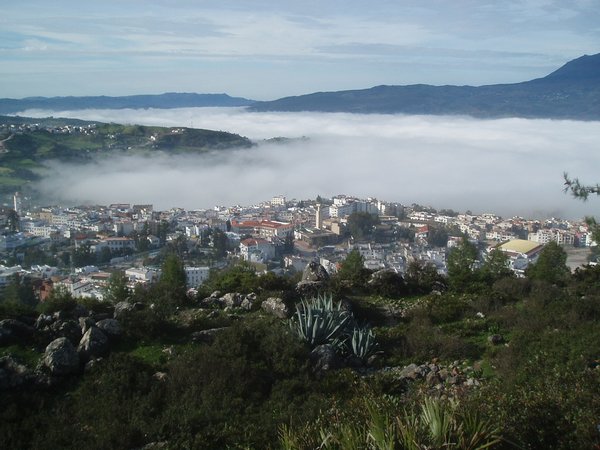
Chefchaouen from above

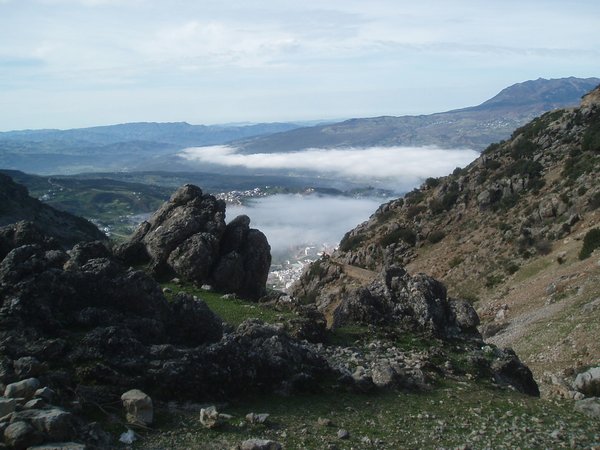
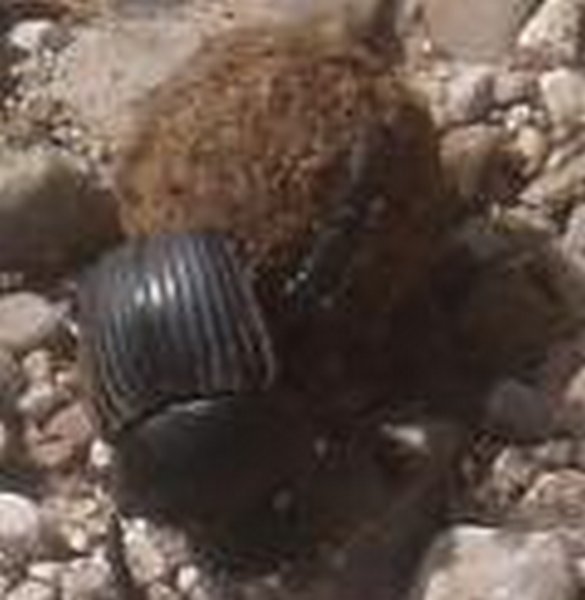
Dung beetle
At first, I had not understood why the kindly hotel owner had insisted on charging me 20 dirham over the listed price, but in the morning I discovered that there was in fact a bathroom right in my room, complete with shower, bidet and sink. I cannot easily justify how I had failed to discover this sooner, particularly since I had scoured the building looking for a sink, but it was certainly a welcome addition.
I got to the old city around 9, which was way too early for most of the shops, but certainly not for the hustlers. And with no other white people in range yet, I was an easy target for every fake guide and leather salesman in the medina's 1200 quiet streets. One section that was open was the pancake quarter where I procured an inch-thick pancake with honey for around 20 cents. The ever-present pancake shops have a host of delicious treats on offer which additionally include giant crumpets and flat quiche-like things - the best by far are the spicy onion pancakes.
The next edible attraction was the rainbow fudge quarter; I purchased a variety pack of the stuff, but soon found that it all tasted exactly the same and had a flavor very much akin to the smell of toilet bowl cleaner. I'm inclined to believe that the guy had tried to save a buck by replacing all the expensive spices traditionally used with bathroom cleaning products - it's hard to imagine that Moroccans could be so enamored with a food of that sort.
I found a bunch of amazing mosques that I was forbidden to enter (including what was probably the oldest university in the world), along with a number of palatial residences, and antiquity shops with curiosities from throughout the medina's 1200-year history. I eventually conceded to following a tout up to a rooftop to look over the immense tanning operation with dozens of dying pools and thousands of skins; they informed me that pigeon poop was used to prepare the skin after it was delivered from the slaughterhouse.
Fed up with getting chased around by "students" (who were "certainly not guides or hustlers but just wanted to practice their English and you could pay them or not, it didn't matter"), I left the old city to try to find the bus station. Somehow my interpretation of the map led me to be perched atop a mud spire overlooking the station a hundred feet below, but a goat path led me down and I was soon on the next bus bound for Meknes.
The ride to the adjacent city only took an hour, but getting across town to the station quickly doubled the transit time. Many of the roads were flooded, thousands upon thousands of pedestrians milled about on all the dry ones, traffic was at a standstill, and the city was more or less a scene of complete and utter chaos. I had been told by a number of touts that all the museums were closed because of an Islamic holiday, but I had believed this to be some sort of trick; it certainly did appear, however, that Meknes at least was in the midst of a massive celebration. A carnival sat across from the station with bumper cars and hundreds of rainbow fudge sellers, the main square had at least ten distinct street performances going simultaneously, and many streets were blocked off for some sort of parade. I followed the book's walking tour and found the medina to be fairly boring, but the Mausoleum of Moulay Idriss on the outskirts of town was highly impressive.
Marrakech was the next stop, but the schedule at the main bus station claimed the last bus was at 6:30PM. Moroccans don't seem to have a good grasp on the concept of overnight buses - this could be because it's not actually possible to sleep on the buses - but they have scores of services that arrive at 2:30 in the morning and seemingly none that finish their tour at a more respectable time. Returning to the station at 8:30, a tout told me I could go to Casablanca, and from there could connect to Marrakech. This seemed highly improbable, since this would put me in Casa after 1am, but I preferred to be moving over being stuck and bought the tickets. I killed some time by dropping by the carnival for a 12 cent ice cream cone and a lamb sausage sandwich, and boarded the bus at 10.
One mystery of Moroccan buses is that, despite the absence of any signage, everyone seems to know exactly when their bus has arrived and will race over and board it the moment it stops. Since I had not acquired this skill, I found myself on a plank in the back, spending the three-hour ride trying to sleep with my head rested on the seat in front of me. Arriving at the next station, I was quite shocked to find that there actually was an onward bus, and I arrived on a random, dark sidewalk in Marrakech just before 6am.

The mellah at dawn
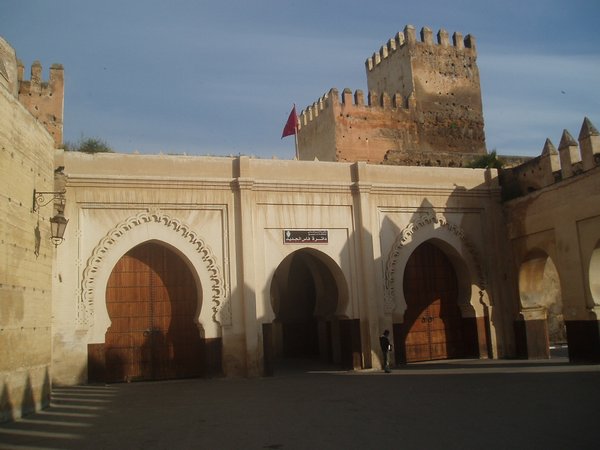

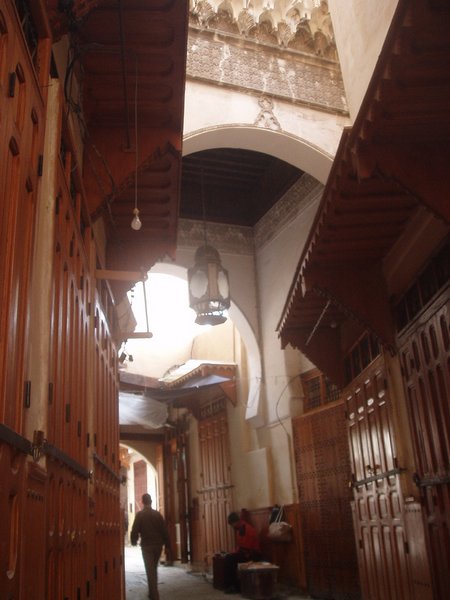
The medina is not an early riser

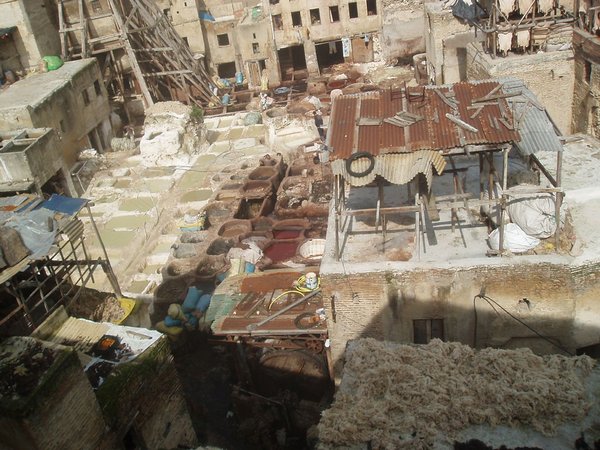
The tannery dye tubs
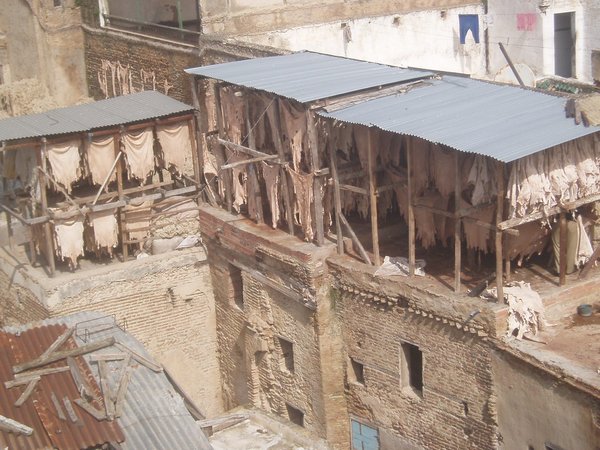
The skins

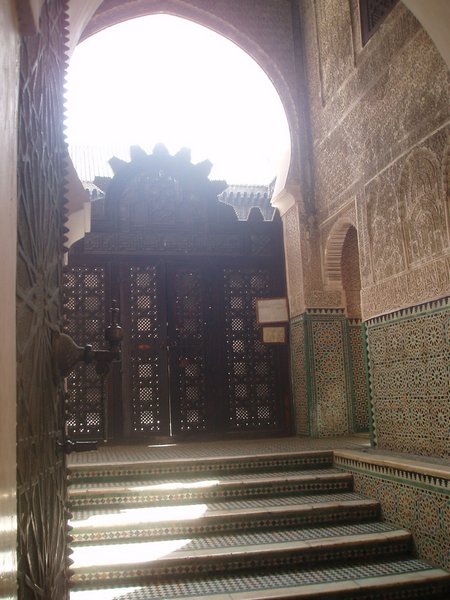
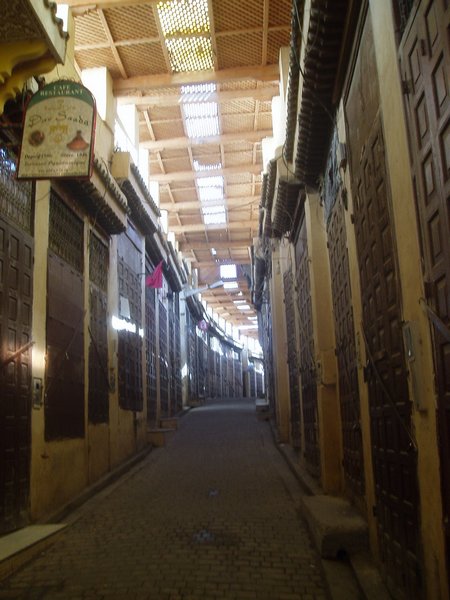
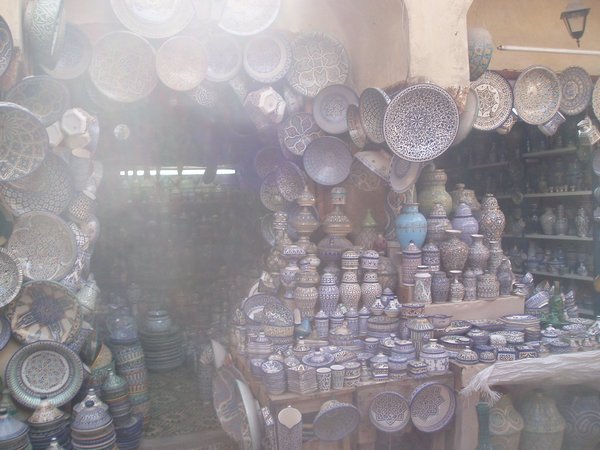
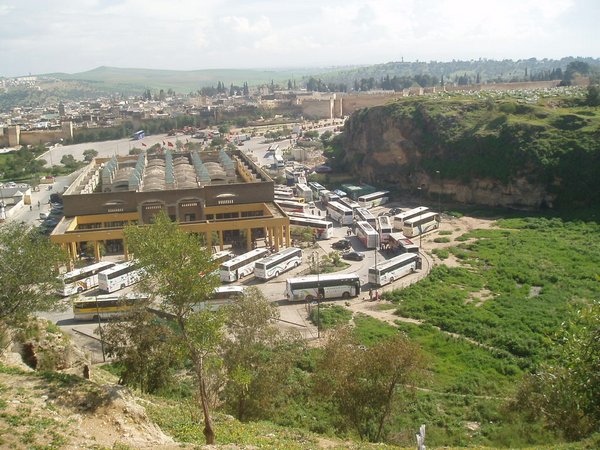
Bus station - separated from me by a 30m cliff
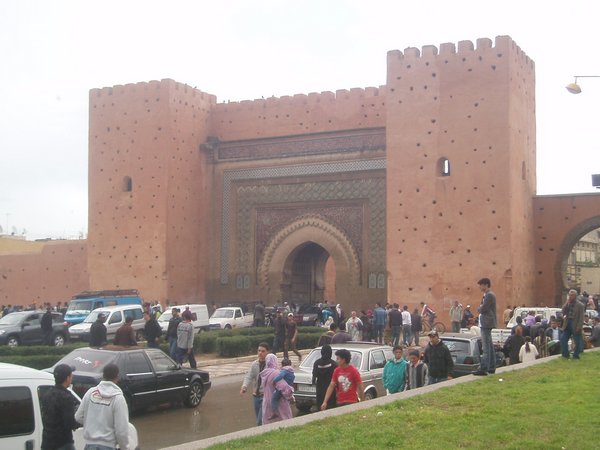
Meknes

Toilet cleaner flavored fudge
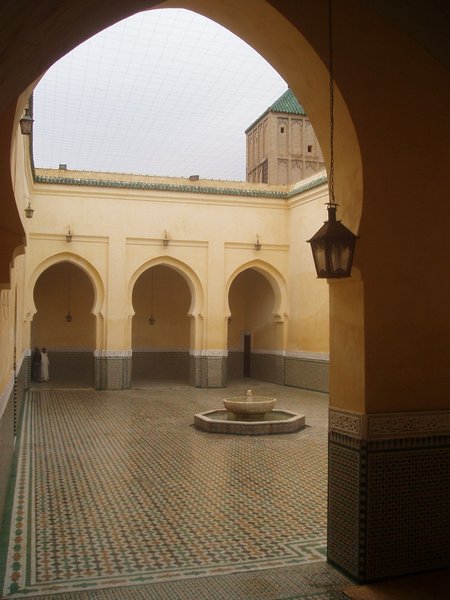
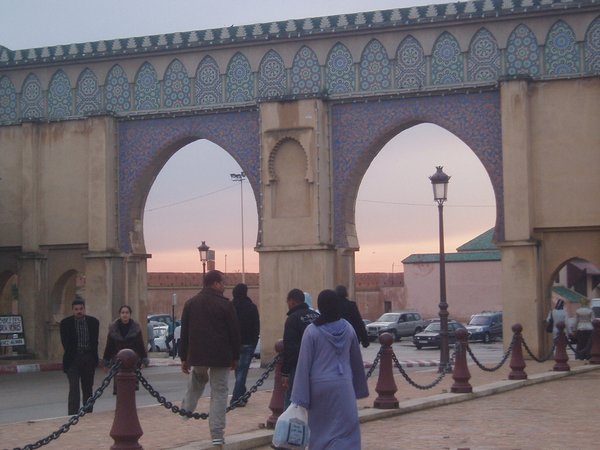
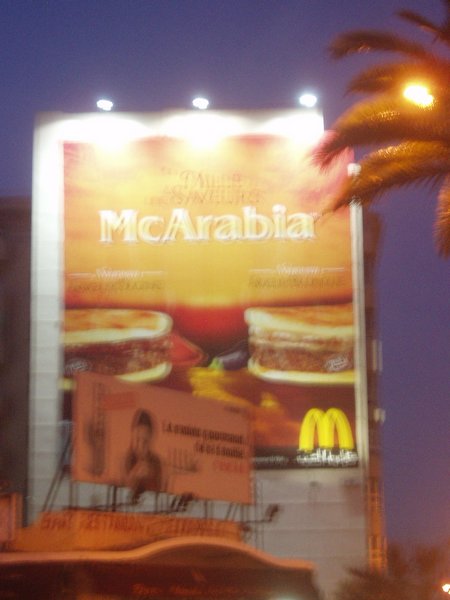
Another one bites the dust...
It was some time before I figured out where in Marrakech I was, and it took a good bit longer before I managed to reach the collective taxi block conveniently located 3km south of town in the middle of the desert. Passengers for the tiny mountain hamlet of Imlil were in short supply (perhaps because they had to walk out to the desert) but once we got moving we made good time; a boulder the size of a house had recently landed in the middle of the road, but a bulldozer had just finished carving an alternative path when we arrived.
In Imlil, I ate at the only open restaurant of the dozen or so present, and then checked into a $5 motel where the advertised "scalding hot showers" had sadly gone on the fritz a few days before. Imlil is just outside Mount Toubkal National Park, which is home to the highest peak in North Africa. Toubkal is oddly hard to identify given its monstrous size, so I just started walking down a road that I imagined would eventually take me somewhere near the summit. Several people offered to rent me a "small boy" for around $10 to show me the way through the mountains, but as usual, I presumed I could figure it out on my own.
Before too long, hiking back and forth along the constant switchbacks started to wear on my patience, and I began course-cutting to skip some of the more unnecessary stretches of road. This was effective for a while, but the last cut, though I didn't realize it at the time, would not return to the road until after I had traversed a treacherous icy peak. I waded through scree and scrambled up boulders for an hour, and, when I was only 30 vertical feet from the top, where I was surely awaited by a breathtaking view of two valleys, my progress was halted by a snow field some 20 feet across. There were snowshoe and donkey tracks running over the surface, but when I went to walk across it myself, I abruptly sank knee-deep into the powder. I brainstormed for ways to safely cross it - an army crawl could work, as might slithering across on my backpack - but in the end, I was forced to admit that I didn't know the first thing about snow and slid back down to the road.
I soon arrived in a massive valley with a dozen or so villages dotting the mountainsides. I followed the high road for several kilometers on one side before descending to a raging river, crossing an inundated bridge, and hiking up the other side. Everywhere there were Berbers washing colorful clothes in the many waterfalls, shepherding herds from atop dramatic crags, or just sitting on their rooftops admiring the views. After some time, a trail appeared that took me down to the river and up a painful series of switchbacks to the starting point. This valley circuit was easily one of the most scenic hikes I've ever come across; it makes a great day trip, but there were plenty of guesthouses with posh accommodation and Berber cooking along the way.
Rather than take the road back, I followed a series of goat paths that led in no particular direction, and I eventually found myself lost in someone's backyard. A family took note of me, and the mother sent her two young boys down to show me the way out and invite me in for tea. I was quite touched, as the gift of tea is the quintessential Berber sign of welcoming and friendship, so I accepted and was led into their humble adobe house. The boys turned on the cartoon channel for me to watch (like most houses in the area, a satellite dish was perched atop the thatch roof) and soon brought out a kettle along with some bread, butter, and olive oil. After a delightful meal where we discussed such things as our respective ages and names, which was about the limit that our French would allow, I thanked them profusely and took out a bag of apricots to give to them (dried apricots are comparatively very expensive and I assumed they must be highly prized). However, at this point the mother showed up and swatted the apricots away, demanding that I pay them cash instead. I stood there for a moment, deeply lamenting not having a better French or Temerit vocabulary with which to teach the boys a thing or two about the principles of hospitality that their mother obviously had never imparted on them, then I pulled a "Look, what's that over there!" and darted past the itinerant mother and fled the village. All the while, the mother stood there shouting after me, while her neighbor laughed hysterically.
I returned to Imlil and found remarkably little to do; I got a bowl of porridge from a small grocer and chatted with some of the locals who wanted me to come live in their village and teach them English - I told them I would have to run the idea by Andie first. I ate a steaming Berber omelet from the same place I had found lunch (still the only game in town), and retired early to my hotel.
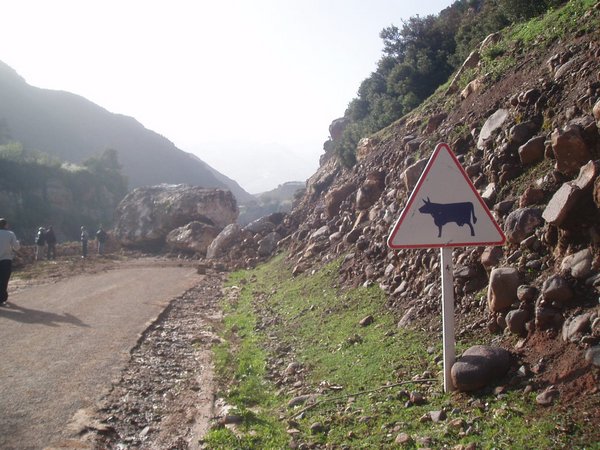
I hope no cows were crossing when this happened
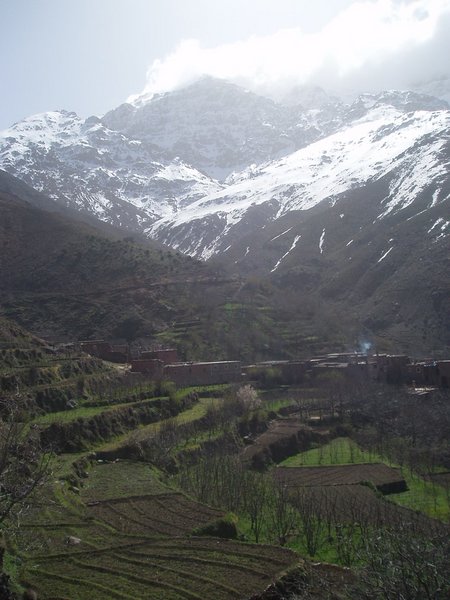
What is this stuff?
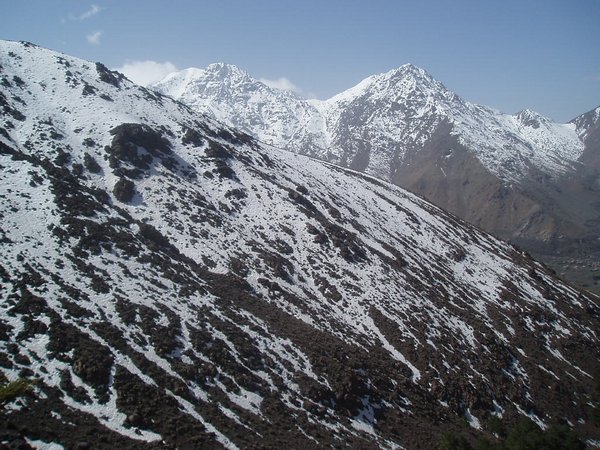
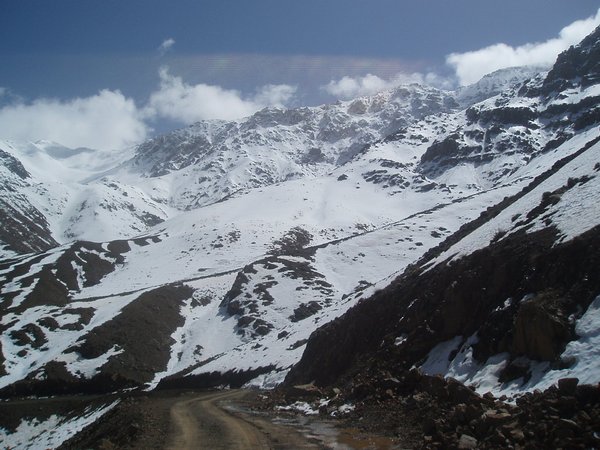
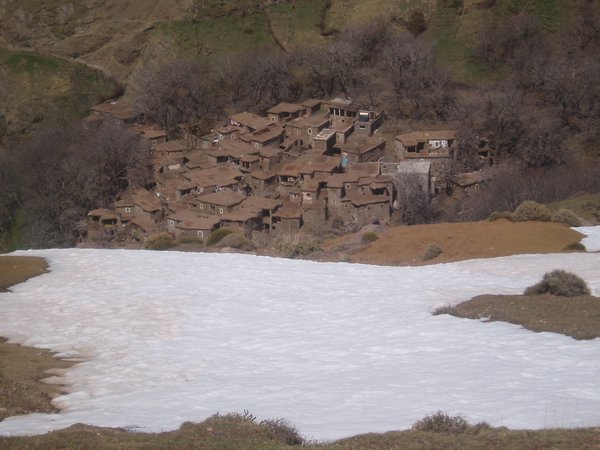
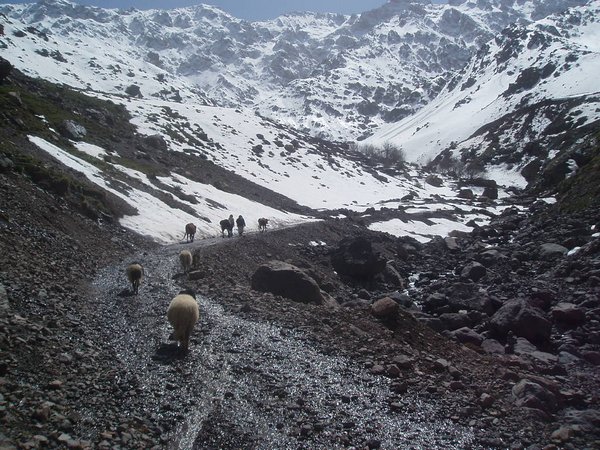
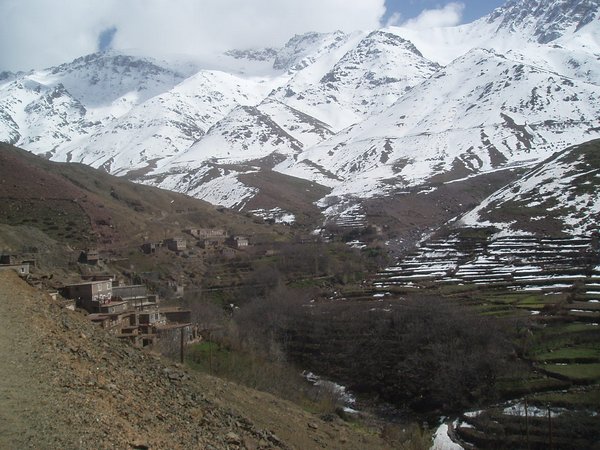


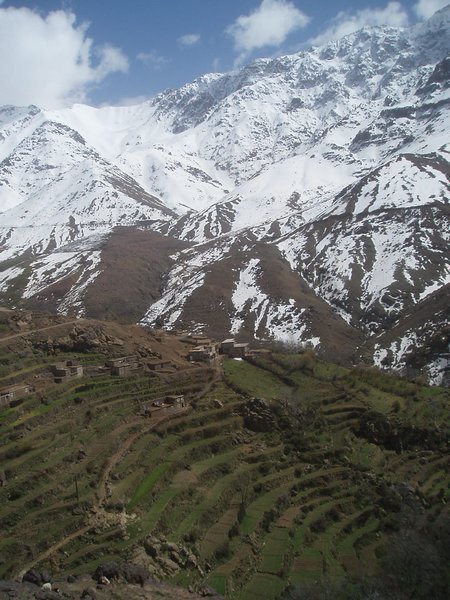
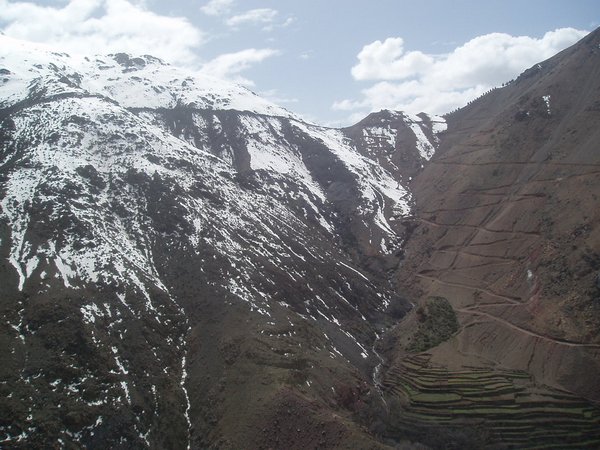

Remote Berber villages
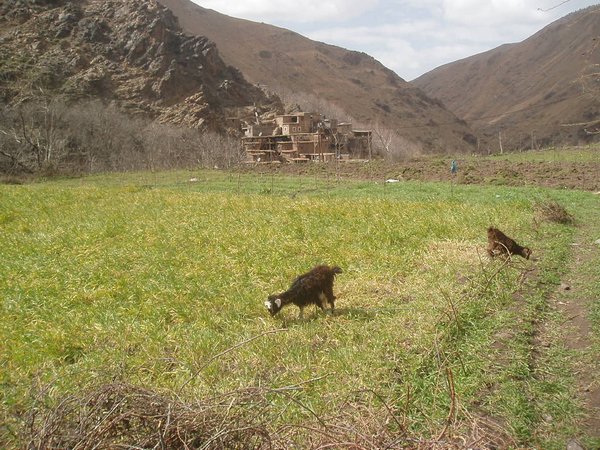
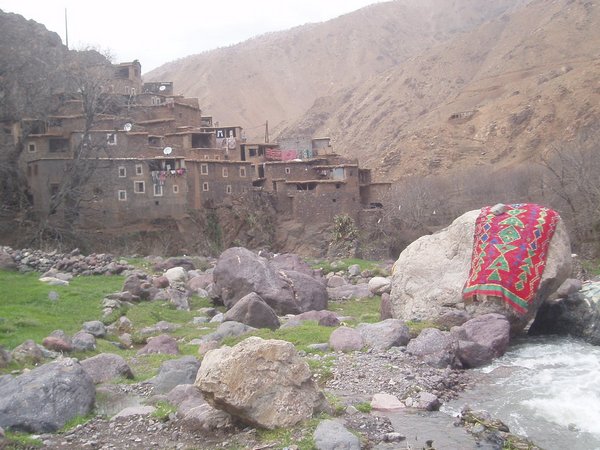

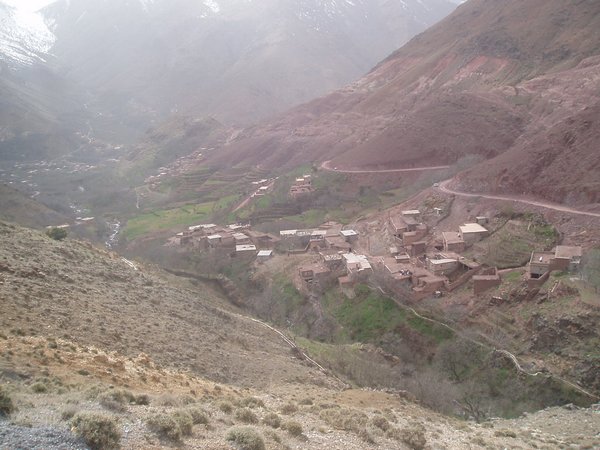
I woke soon after dawn and squeezed into a cargo van with the rest of the village to go up the road to Asni. Thirty-five people is a few too many for your standard 11 passenger van and I came quite close to getting sick, but the 17 curvy kilometers ended just in time to avoid what surely would have been a profoundly awkward situation. There were many ways to get to Marrakech from Asni, but for some inexplicable reason I chose to go with the 60-passenger bus. This led to an excruciatingly slow and terrifying ride, as the bus somehow negotiated the hairpin turns on the one-lane road hanging precariously over a giant gorge, and miraculously managed never to collide with any of the slew of oncoming cars that came barreling around the blind turns.
Back in Marrakech, I dove into the chaos of the medina. Unlike every other medina in the country, this one allowed vehicular traffic; motorcycles (and the occasional taxi) would tear through the narrow pedestrian- and merchandise-packed alleyways at suicidal speeds; this made the whole shopping experience a lot more life-threatening than it really had any reason to be.
Two of the principle attractions, the Musee du Marrakech and Medersa, didn't have much in the way of exhibits (and all the signs were at any rate in unintelligible languages) but the buildings that housed them were simply incredible. Of course, the most important feature of any Marrakech museum is the momentary respite it provides from the chaos that permeates every inch of the city - and, naturally, the clean, free bathrooms.
After a tour of the remaining attractions, including the Bahia Palace and Saadian Tombs, I returned to the souks to do my souvenir shopping for the trip. As usual, it was a royal pain, but with only an hour of haggling I managed to procure three reasonably-sized uniquely Moroccan things that I would be hauling on my back for the remaining days of the trip.
With only half an hour to spare until my bus would leave for Essaouria, I sprinted to the station; arriving 15 minutes early, I found no bus there; I did not think this extraordinary at the time as the buses tend to leave at least an hour later than announced. However, after talking to a number of people, I learned that my bus had actually come and gone well before its scheduled departure time. The office that had sold me the ticket had closed for the day, but some random guy was able to exchange my ticket for another one for the next morning; this seemed like a less than satisfactory solution, but there was remarkably little I could do about it, so I resigned myself to staying in Marrakech overnight.
I returned to the old city and sought out Hotel Essaouria (because it was the cheapest in the book, and not to provide some sort of substitute for the charming seaside town that I would likely never see). The place was full, but they were willing to let me sleep on the roof for $3; the specifics of this arrangement were a little sketchy (no sheets, blankets, pillows, or luggage storage) so I went to a nearly identical place across the street and got the one remaining room (twice the normal price since it was a double) for $12.
My hotel was all of a hundred meters from the famed Djemaa el Fna, a UNESCO world heritage award recipient for live theatre. It was in full swing when I arrived with hundreds of food stalls, street performers, carnival games, exotic animal shops, and hundreds of locals and tourists drifting from one attraction to the next. I passed up the many sheep head and brain tables (though there were a surprising number of white people patronizing these) and found a stall with a more traditional menu; I had tried most everything in the standard Moroccan repertoire, so I ordered the two remaining options, taglia (which turned out to be several chunks of meat floating in olive oil) and a pastilla (chicken or possibly pigeon, honey, and almonds, with a flaky crust). These were washed down with cinnamon cake and tea at a stand across the way.
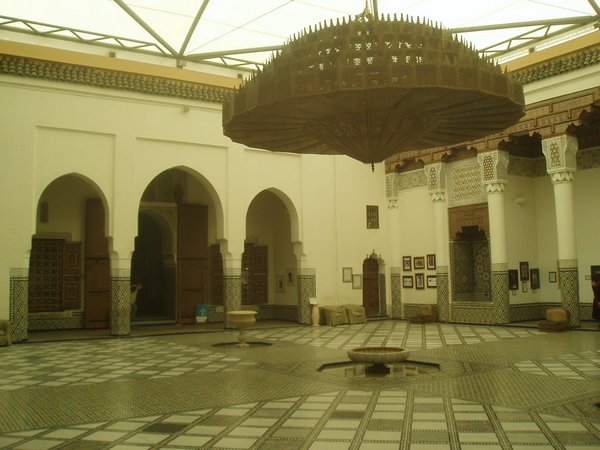
Musee du Marrakech


The hamam
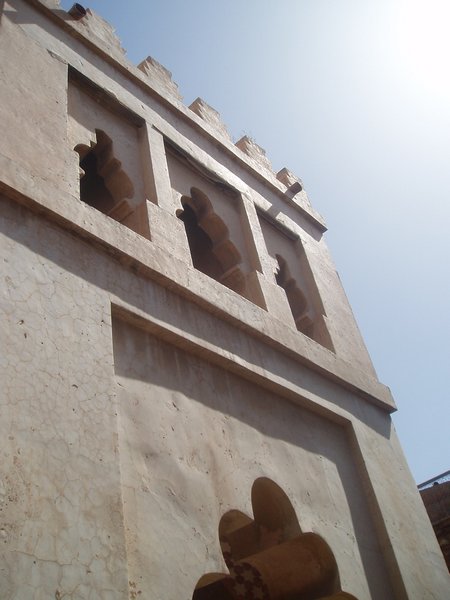
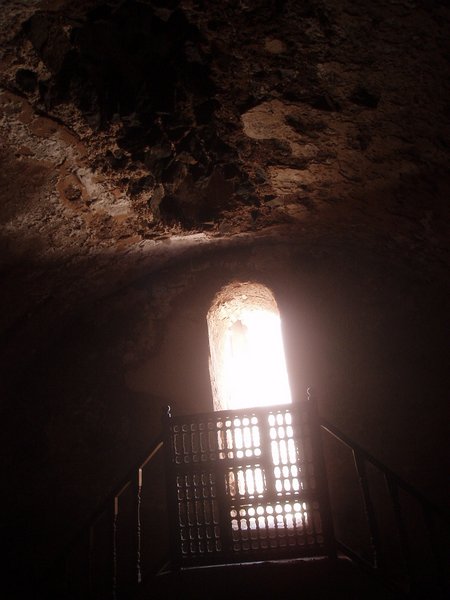
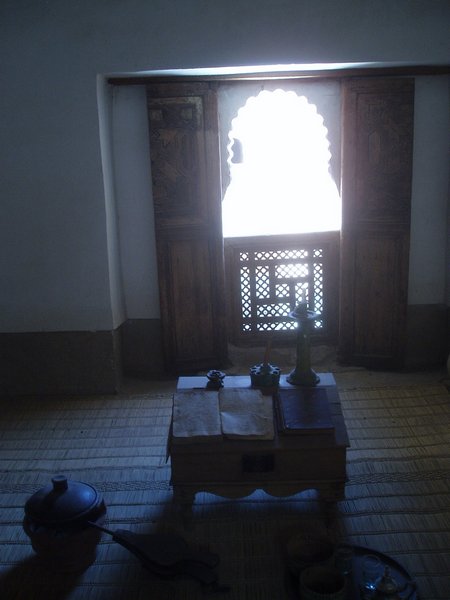
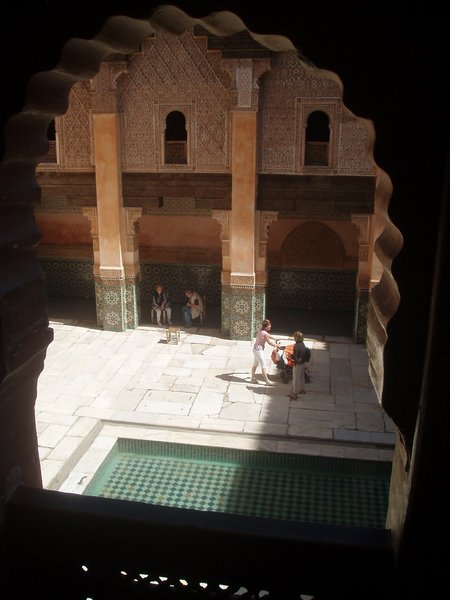
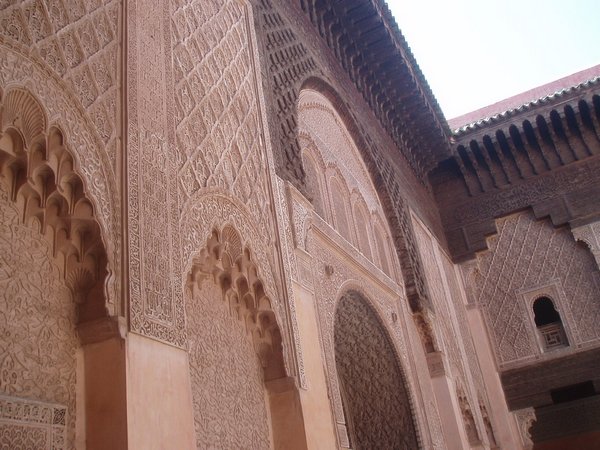
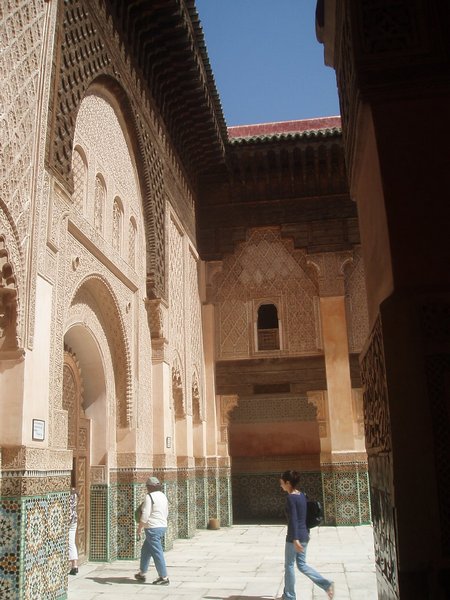
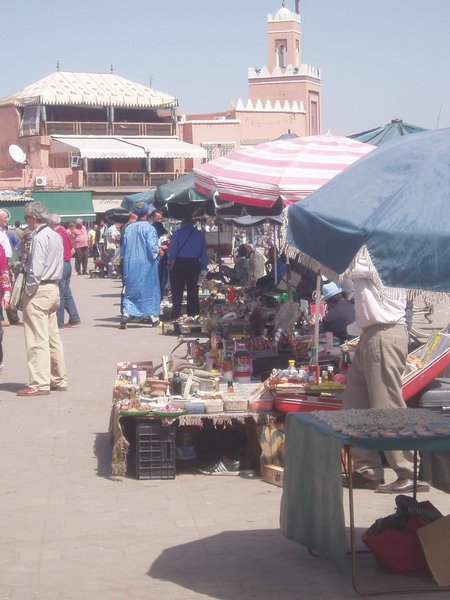
Rare animal sales in the Djemaa el Fna
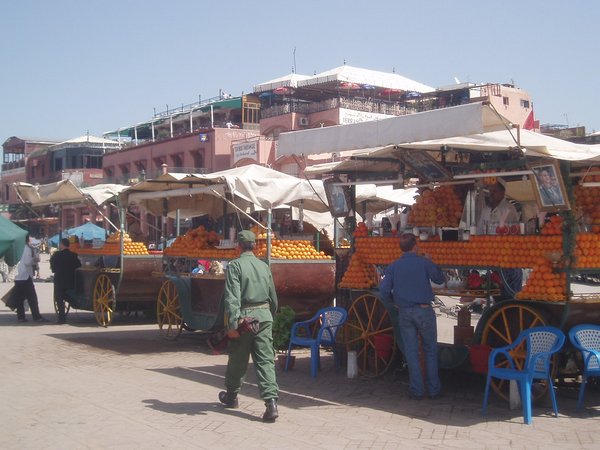
Orange juice
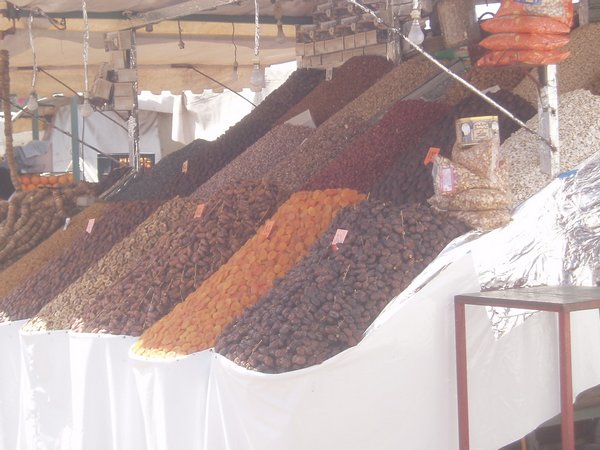
Dried fruits

Monkeys for pictures
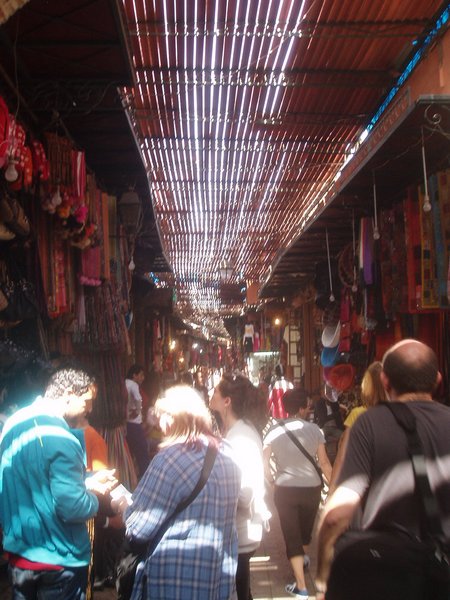
Souk
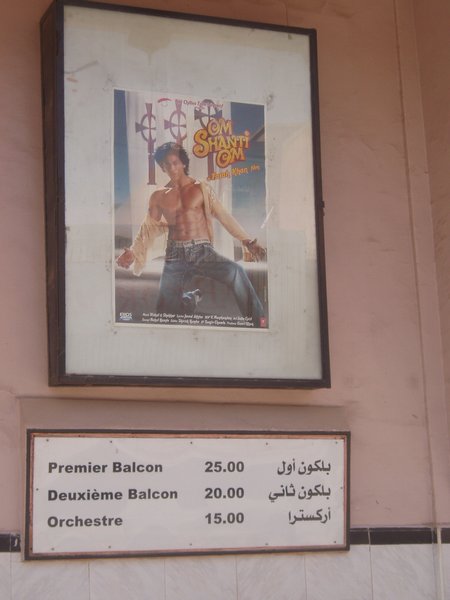
At the cinema

Spice stand
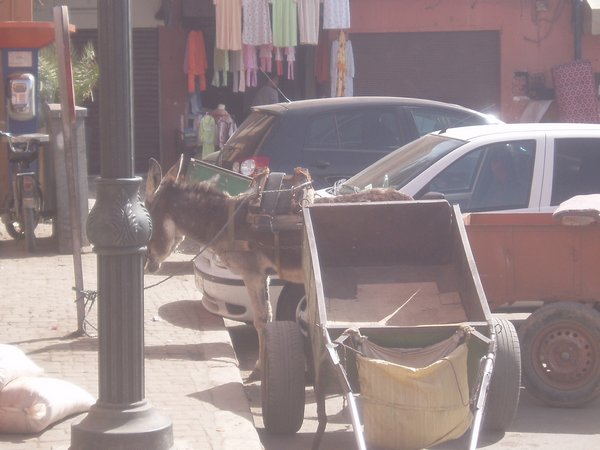
Donkey parking

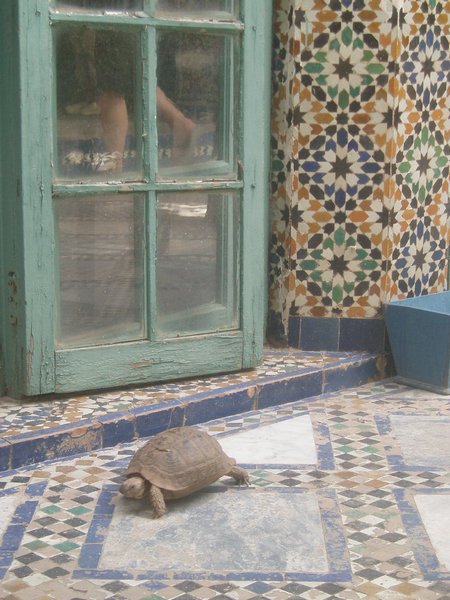
Palace visitor
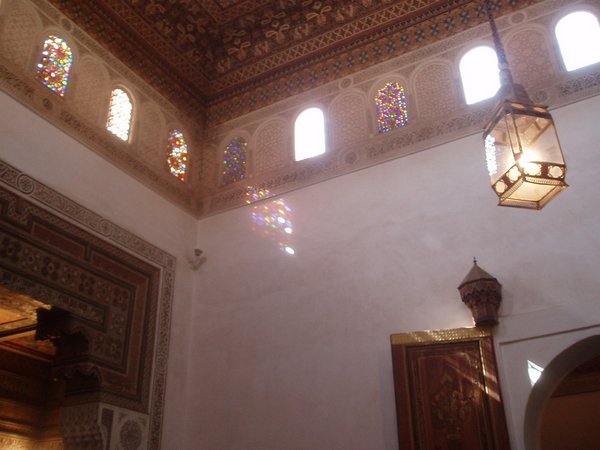
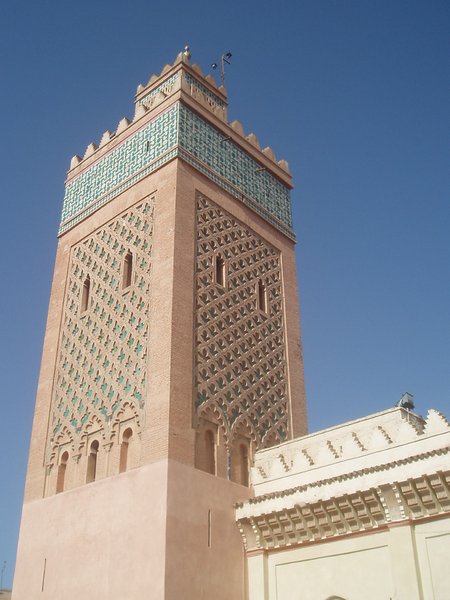
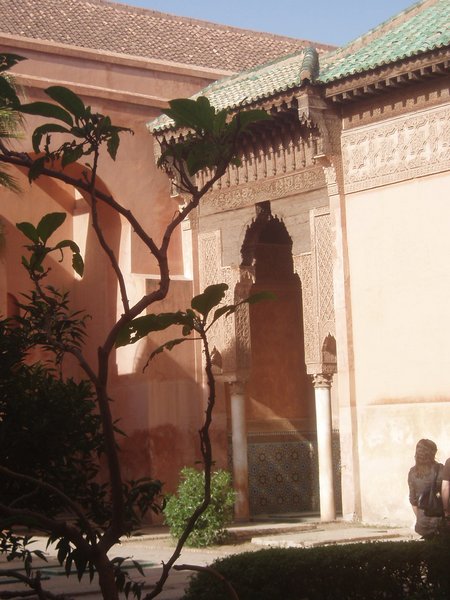
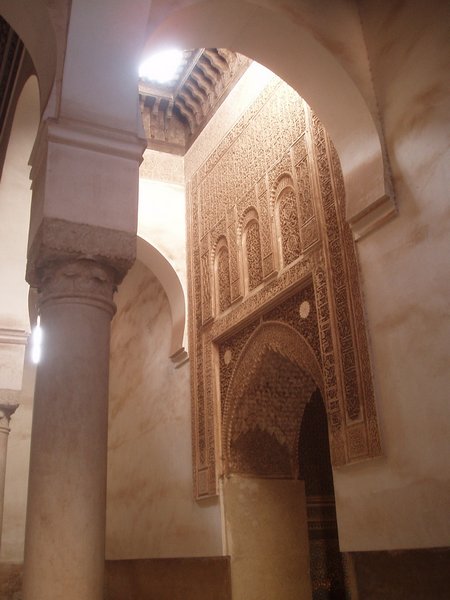

Street performers
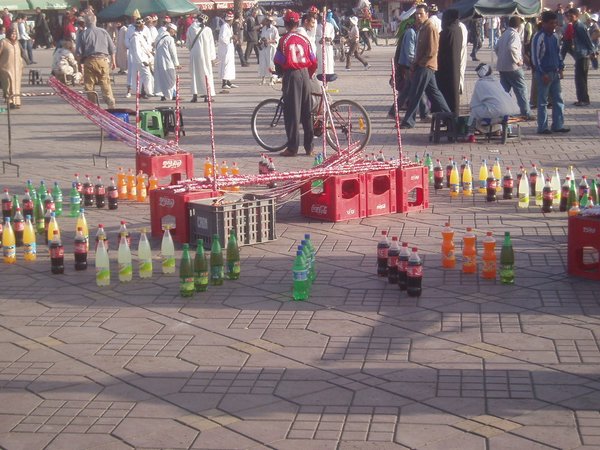
What could this be?
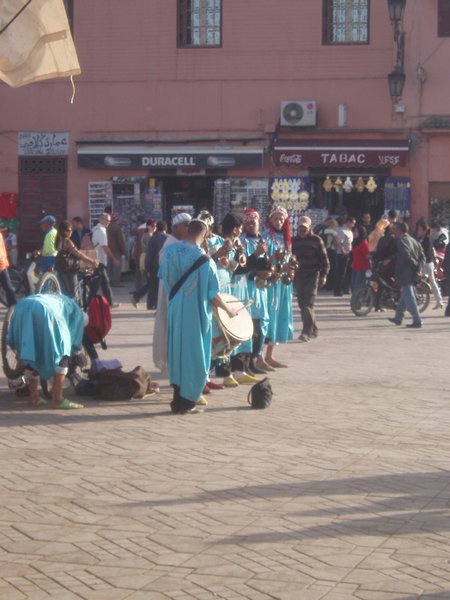
West African drum band
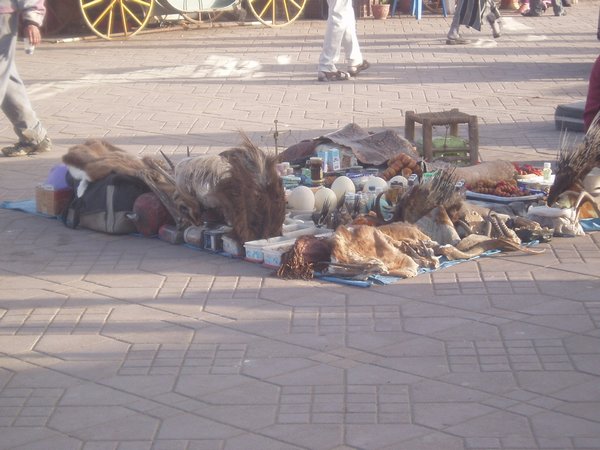
Rare animal products - probably couldn't get these through customs
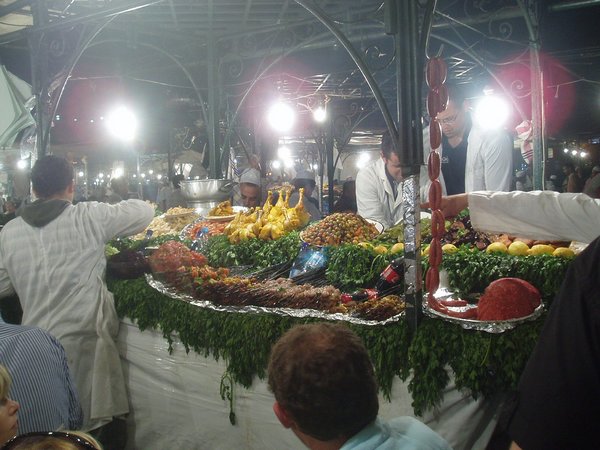
Dinner stall
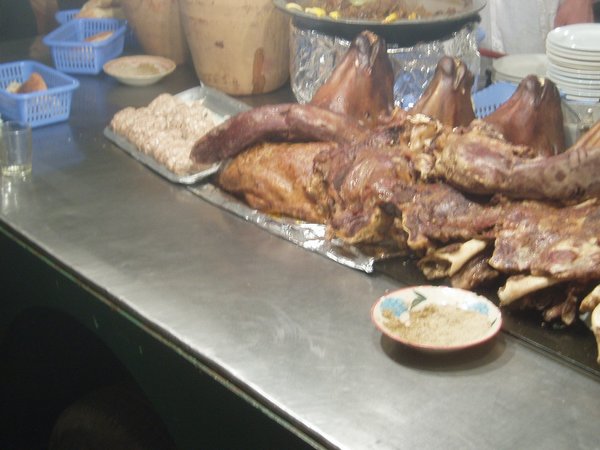
Sheep heads and brains (left)
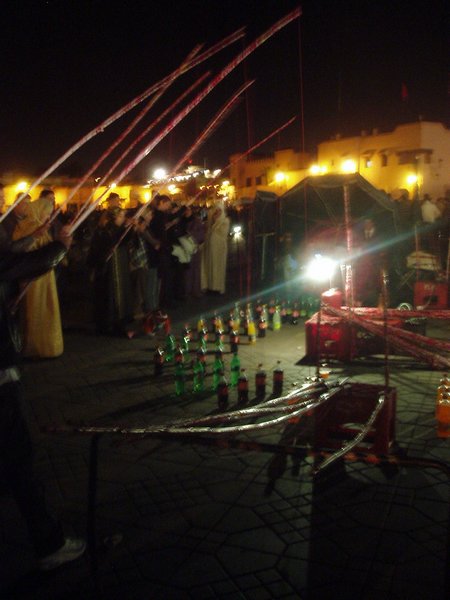
Carnival games

Snail stands
I awoke at 5:30 and walked through the silent streets of the medina to the bus station. The guys at the ticket window explained that they could'nt give me my money back because they were with a different company, but if I waited until 8:30, then I would surely be given a refund. There was little doubt in my mind that I would never see that 40 dirham again, and I didn't feel much like waiting around regardless, so I forfeited the $4.50 and got a second ticket to El Jadida.
A four-hour bus ride and a bit of hiking later, I arrived at the old Portuguese city. The place was a bit run-down and rather quiet, but it did have some neat fortifications and a lighthouse turned minaret. The coolest attraction by far was a cistern where a single beam of light illuminated a room full of pillars and arches, and showed the reflection of the elaborate ceiling in an inch of water that rested on the floor. This place was made for photo ops, but without a tripod, it was no little effort to get that perfect shot.
Despite my frequent travels over the past week, I still found it completely impossible to express when I wanted to go to the bus station - whether this was due to my poor pronunciation or whether it was because the words that were emblazoned across every bus station and every sign for a bus station were somehow just not in the local vernacular, it was just an idea I could not get across. When trying to get off the local bus at the El Jadida station, all the passengers fervently insisted that I actually wanted to go somewhere else, but I got off anyway, apologizing to all, and found a ride to Casablanca within 5 minutes.
Casa is a huge modern city with relatively little in common with the rest of Morocco. Few women wear headscarves, the medina is tiny, and I don't think I saw a single donkey cart the whole time I was there. It has long been said that the city only has one real attraction, the gigantic Hassan II Mosque, but while, as the third largest mosque in the world, it is plenty impressive, I think I found something to top it.
The Cathedral of Sacre Couer is a huge French construction that has long since been gutted and left to rot. When I dropped by, they were hosting a children's art festival in the cavernous, empty interior, and a Zero-G chair was set up where the altar once had been. This was of course, vaguely unsettling, to see this great monument to my religion and to western civilization, irrevocably conquered and resting like a great bleached skeleton in an alien landscape. But when some random guy offered to let me climb the bell tower for $2, I hardly saw how I could refuse.
The winding staircase to the top of the tower was covered in feathers, pigeon poop, nests, and eggs; this clearly was no mainstream tourist attraction. A few flights from the top, it was possible to leave the tower and walk the full length of the roof; the opposite tower was just an empty fašade, and I lay down in the poop to look over the edge without risking tripping into the abyss. I climbed the rest of the stairs and found the only way to reach the bells was a series of 20 iron rungs, completely covered in crap - I decided the visit had gone on long enough and returned to the ground floor.
I crossed the city to the great mosque and peered through the massive doorway; the place was only open to tourists on guided tours and only at three times in the morning and afternoon, so, while the faithful freely walked in and out, we white people stood precariously teetering on the threshold, trying to get a good shot of the exquisite interior.
Back in town center, a lively night market was underway. The specialty of this market seemed to be yogurt drinks. There was also someone with a cart of pastel-colored baby chickens, though I never figured out why someone might buy one of these.

The Portuguese Cistern
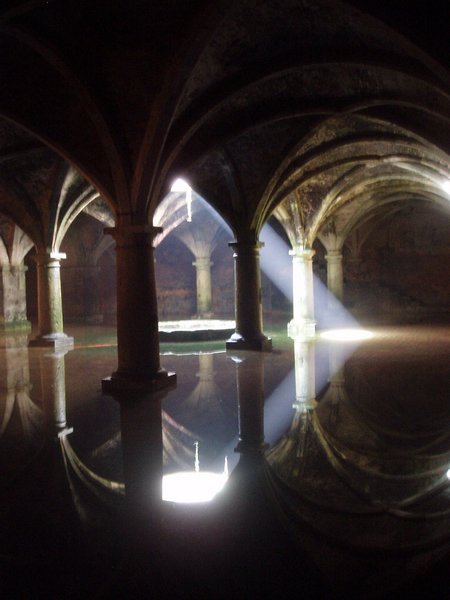
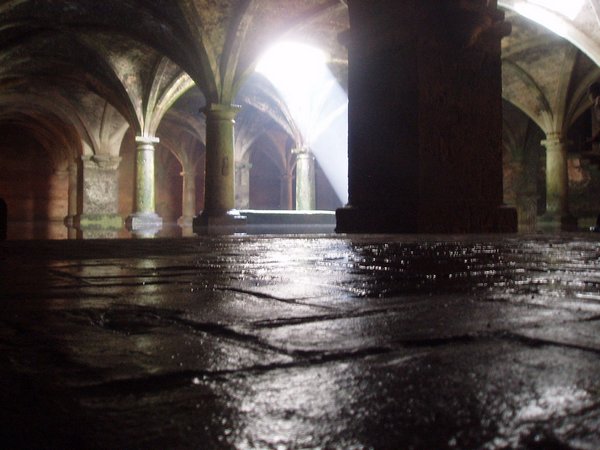
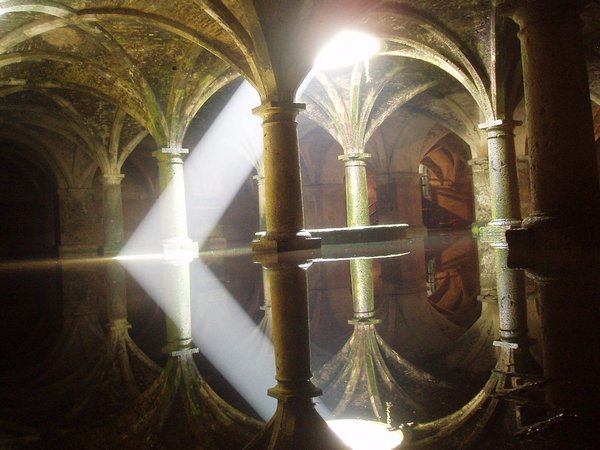
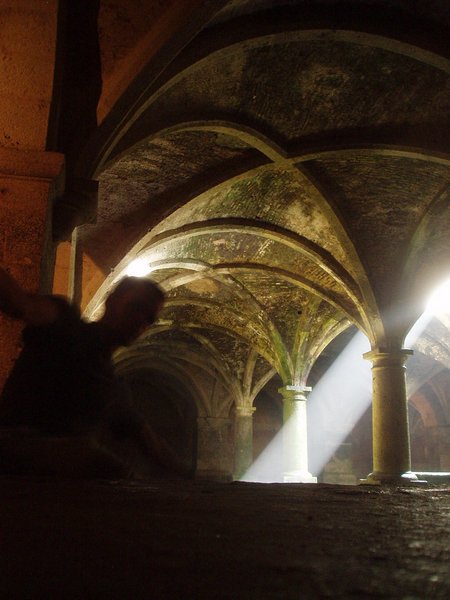
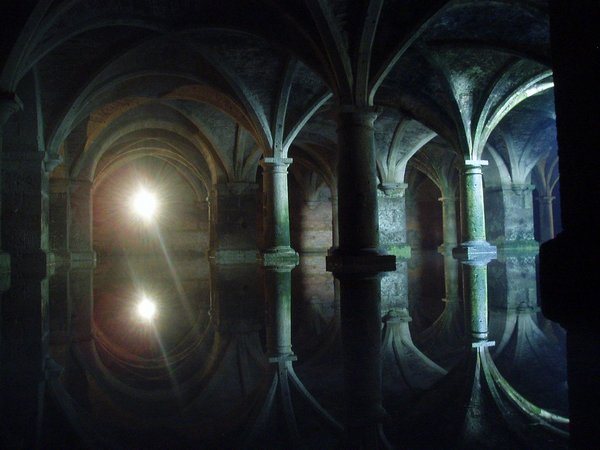
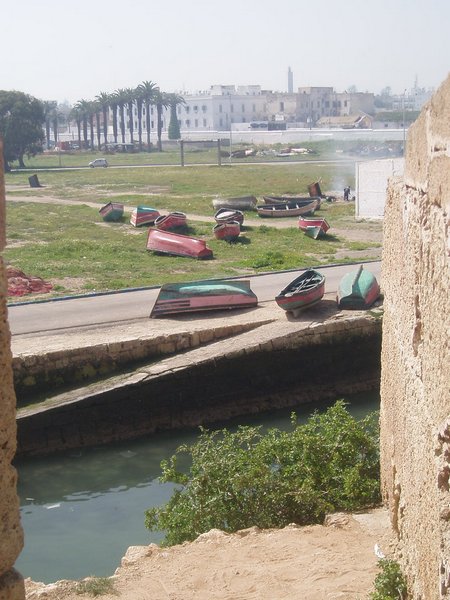
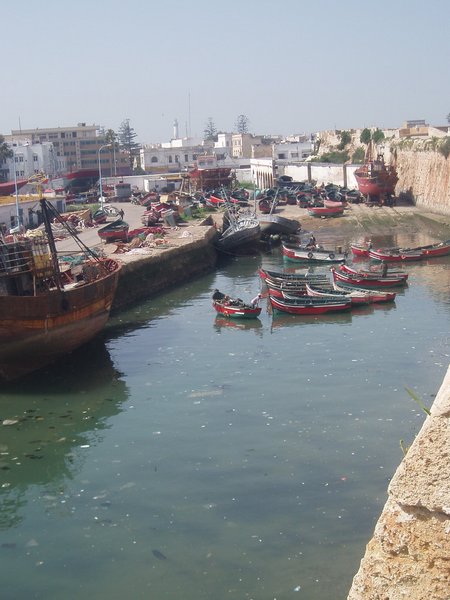
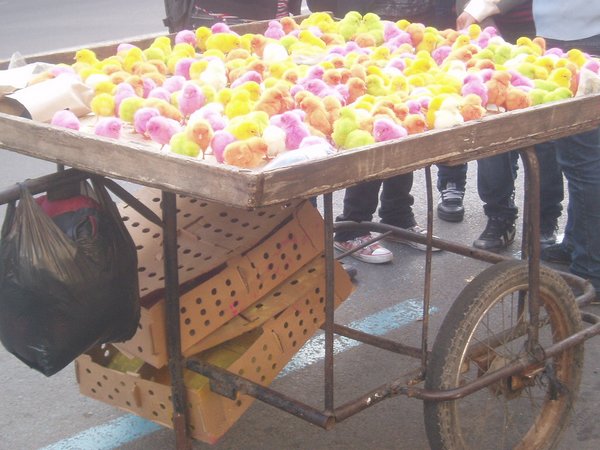
Pastel nuggets
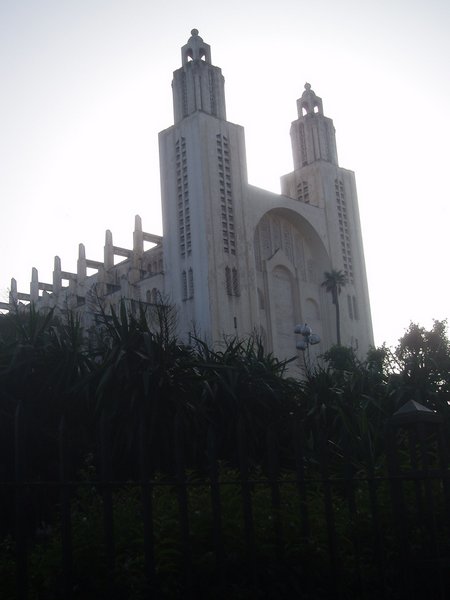
Abandoned cathedral
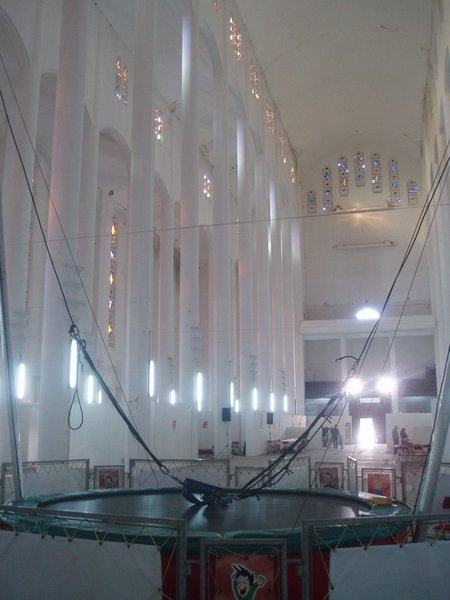
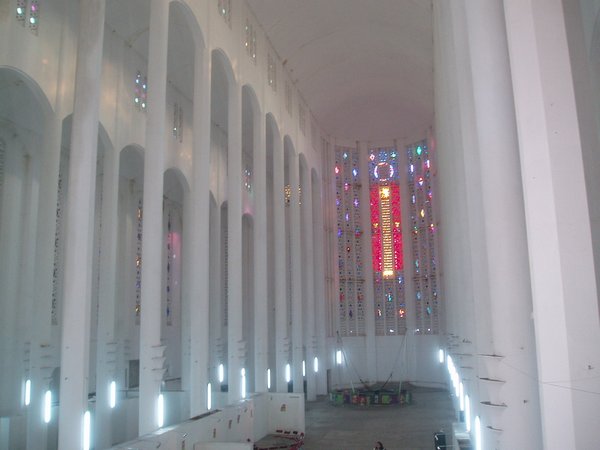

On the roof
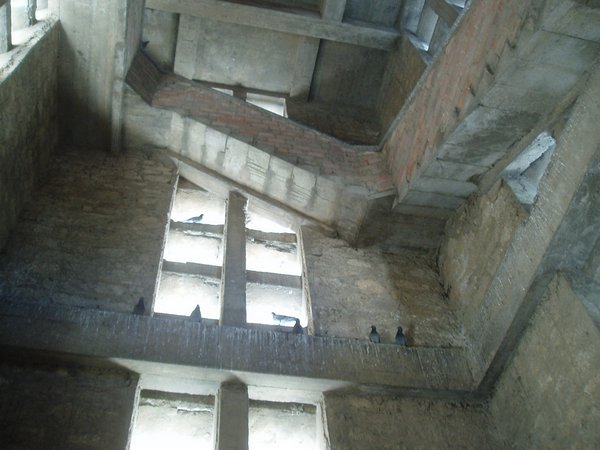
Pigeons in the belfry
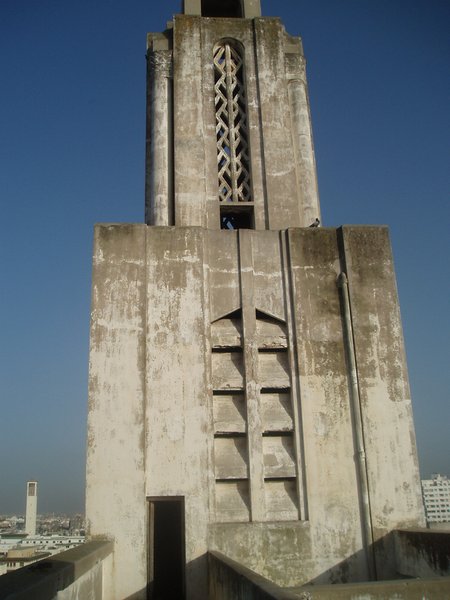
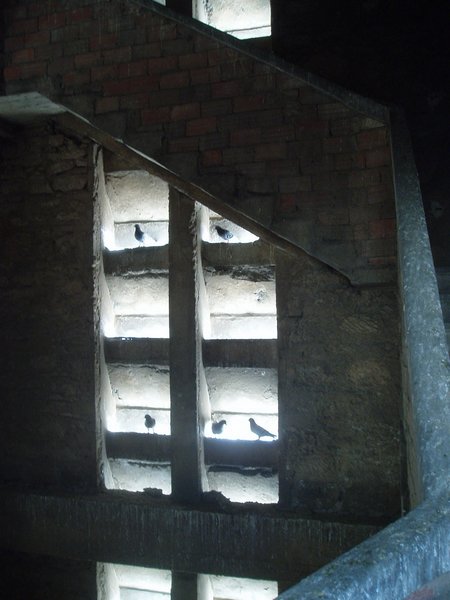

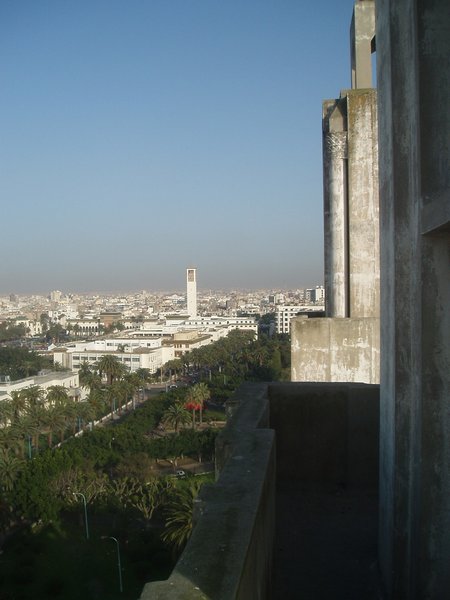

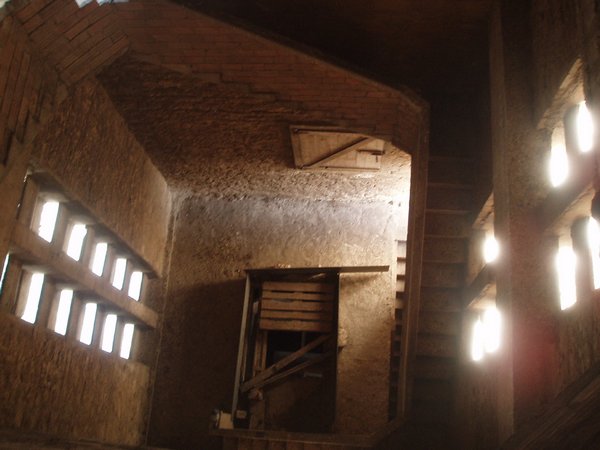
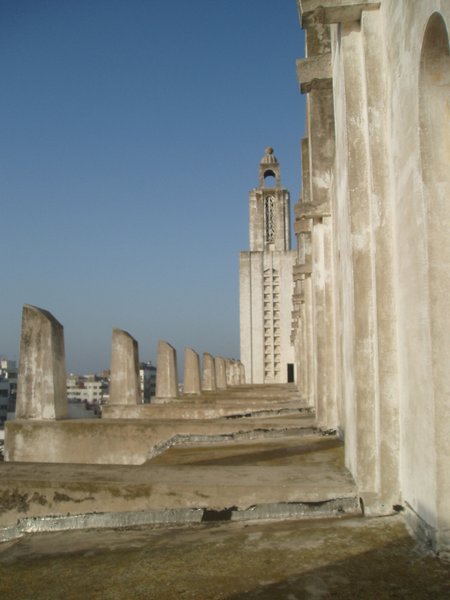
From the other end


The post office
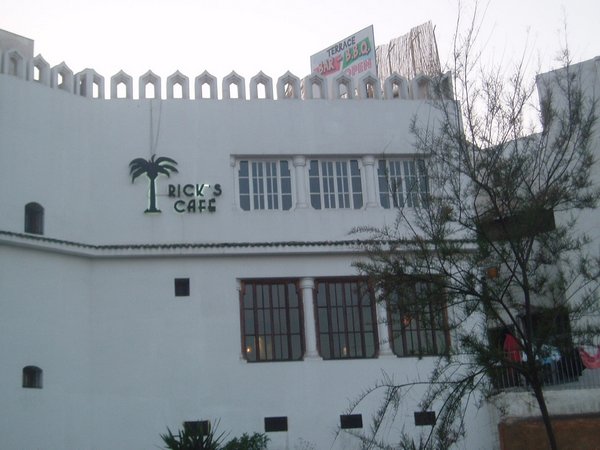

Third largest mosque in the world
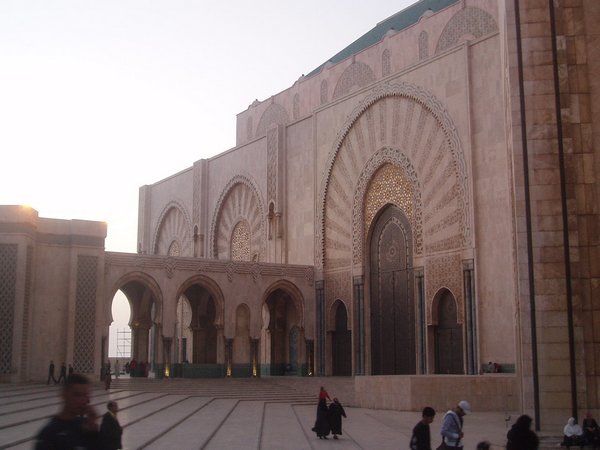

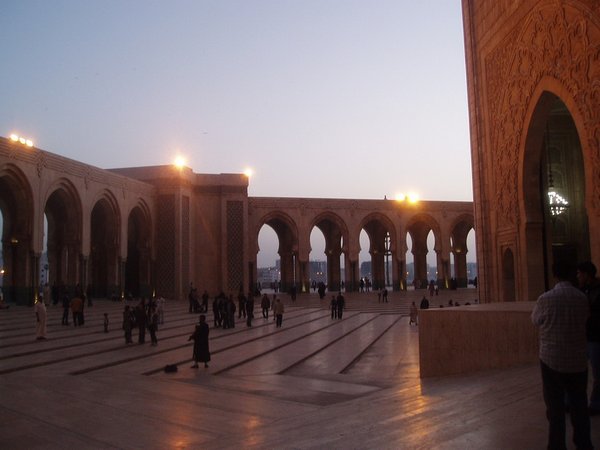
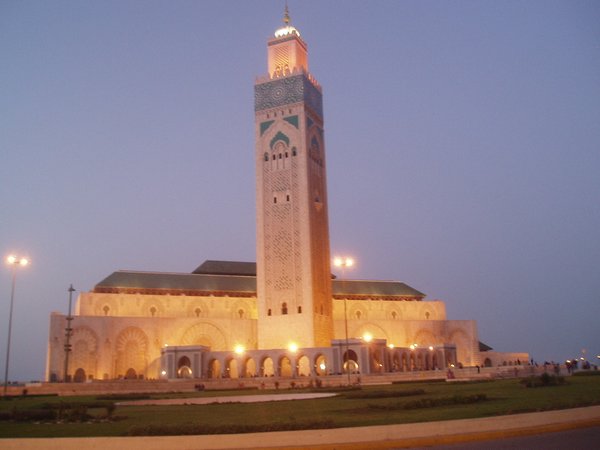

I knew my buying power would soon be significantly reduced, so I sought out a substantial breakfast of oatmeal (with olive oil), yogurt, and a giant slice of chocolate cake - all of this added up to around 80 cents. Lacking the energy to find a cheaper way to the airport, I once again boarded the $4 train. On the way, I was befriended by a suspicious character from Cote d'Ivoire who was in Morocco to "do business" and was flying home without any luggage; he lost interest in me after I declined to give him my phone number, so I never figured out what his game was. The Casablanca airport has just a smidgen more amenities than a typical Moroccan bus station, but is short on chairs, water fountains, and toilet paper. After a four hour wait, the plane ride was only a tad over an hour, and I reached Madrid Barajas by 5.
Madrid gets serious kudos because it is one of the few cities in the world that doesn't gouge passengers on transport to and from the airport. You can board the subway or a bus straight from the terminal and go anywhere in the city for a single euro. After three quick train switches, I emerged in Plaza de Callao. Here, there was a protest in progress (against what, I'm not sure, but they had a great drum line) and further down the pedestrian walks radiating from the plaza were human statues, balloon artists dressed as Disney characters, and immigrants selling bootleg DVDs.
I secured a spot in one of the 14-bed rooms in Cat's Hostel for 17 euros. This turned out to be a wonderfully efficient and pleasant institution that managed to comfortably cram hundreds of backpackers into a space the size of a two-story house. The building is historic and looks like it has been pulled straight from the streets of Marrakech.
The Rena Sophia museum has a free day every Saturday with hours until 9, and I arrived just in time to take advantage of the last hour and a half. The place had some good stuff by Picasso and Dali, plus a few floors of modern crap. One interesting work was a virtual reality shopping simulator where you could push a cart along a track and see products displayed on the wall; of the myriad potential applications for VR technology, this certainly seems to be one of the less compelling ones.
I started to wander around the city to browse the restaurants and nightlife for which Spain is famous, but soon found I was completely exhausted and returned to my hostel around 10 - a good 8 hours before most Madrienos would retire for the night.
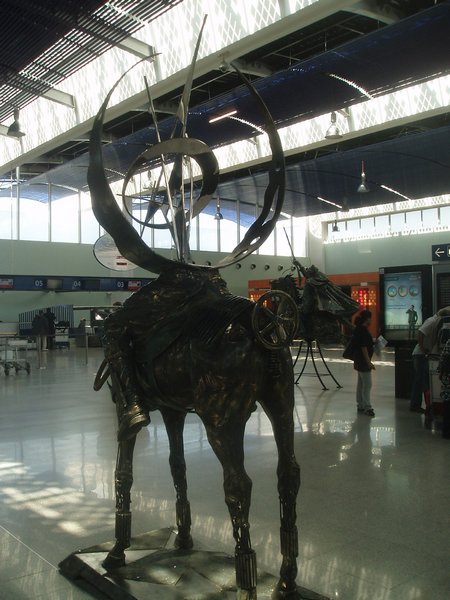
You think things will return to normal once you reach the airport? Think again.
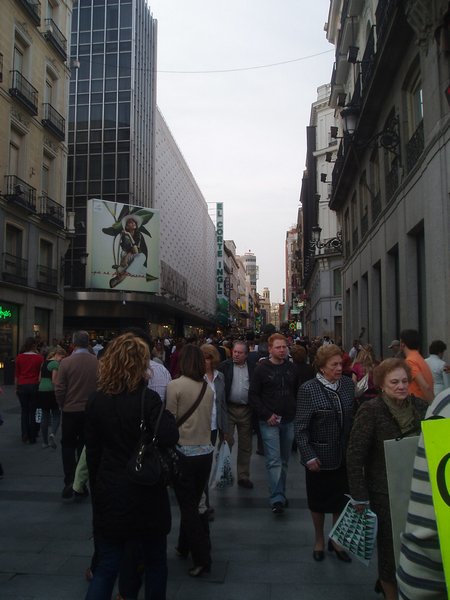

Cowboy statue

The cows strike again!

A protest of some kind
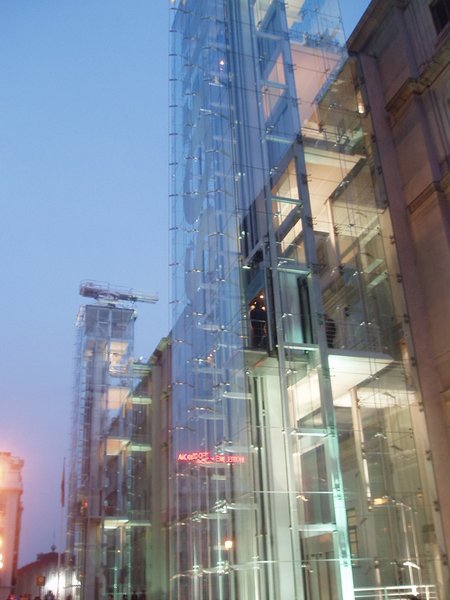
Reina Sofia
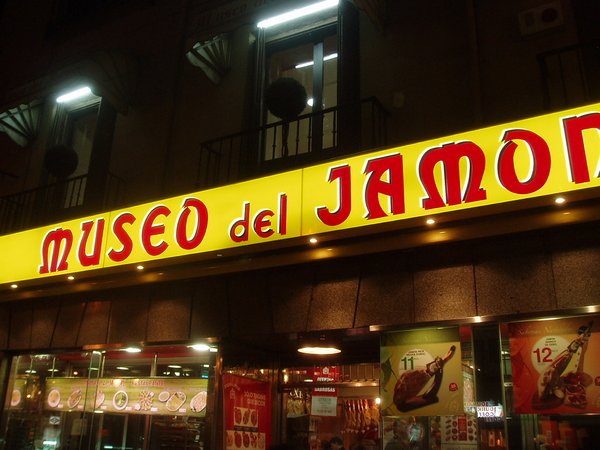
Museum of Ham (a chain restaurant) - Spaniards sure love their ham
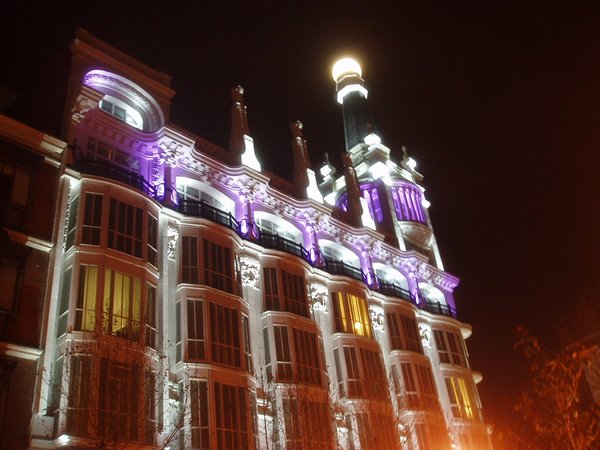
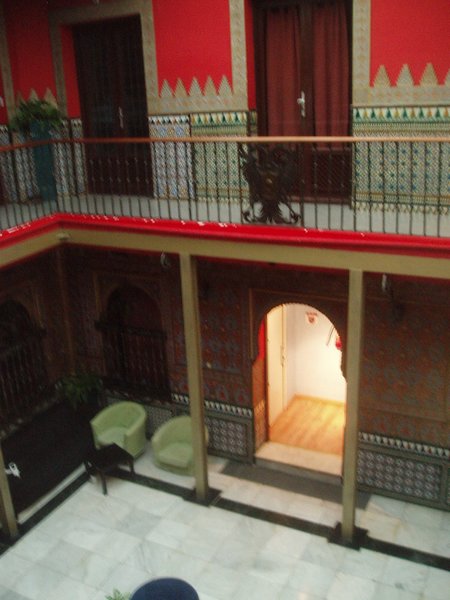
Cat's Hostel
My hostel's free breakfast of cornflakes, toast, hot chocolate and juice would be nothing special in the UK or Germany, but in Spain it served as a very welcome escape from the coffee and ham sandwiches that would be the only option on the streets. Eating in Madrid at all was an ordeal - Menu del Dias are considered a steal at 10-20 euros, and these are only available Monday through Friday for lunch; other options are considerably more expensive, and restaurants typically don't start serving lunch til 2 or dinner til 9 anyway. The Hari Krishnas have a counter that serves food precisely at 3 on weekdays for an uncharacteristically steep 6 euros. What does all this leave for me, the budget conscious backpacker, given that I was only there for the weekend? Kebab shops. At these, you can get a pita with meat, lettuce, tomato and sauce for 3 euros.
I started the day in El Parque de Buen Retiro, a huge green space with fountains, statues, and palaces, as well as hordes of cyclists, runners, rollerbladers and cross-country skiers. From there I went to a nearby church, where the elderly priest had managed to get through all three readings and half the homily when I showed up eight minutes late; with one Mass scheduled each and every hour, the Spaniards are experts at speed services.
On the opposite side of town, I found the Temple of Debob, which is an Egyptian edifice that was transported brick by brick from a soon-to-be-inundated plain. My low-calorie breakfast was beginning to wear off by this time so I popped into a convenience store where I was enthusiastically greeted by a little Peruvian named Pedro - why he was so thrilled to see me was unclear, but he explained every product in his shop and made sure I got a decent lunch.
Plaza Mayor seems to be the midday hotspot, and it was hosting a collectible sale when I arrived. Down the road, El Rastero was packed with shoppers looking for bargains at the district's weekly flea market - my bag was already full to capacity, so I had to forego updating my wardrobe with the latest European fashion.
The Museo Thysse-Bornemisza was the next stop - it lacked the free periods that most of the town's museums offered, so I had to part with four euros to see what was lauded as "possibly the world's largest private collection of European art". From here, it was on to the Prado in time for their nightly free period. At first, it was not clear to me why anyone should ever pay for a museum that's free every night, but when I saw the massive line out front, and subsequently the hordes of people pushing their way through the grand hallways, it became all too clear why someone might want to pony up a few euros for a bit of quiet appreciation.
I followed the throngs of people through a circuit of the plazas; the highlight of the evening was a chance encounter with a man and his ferret - the man was attempting to walk his ferret down one of the main pedestrian drags, but the creature just sat down on its haunches and refused to go any further. When I passed them, they were in the midst of a heated interchange, where the man would insist that the ferret keep walking, and it would shake its head to refuse - this reminded me a bit of some of my travel experiences with Andie.
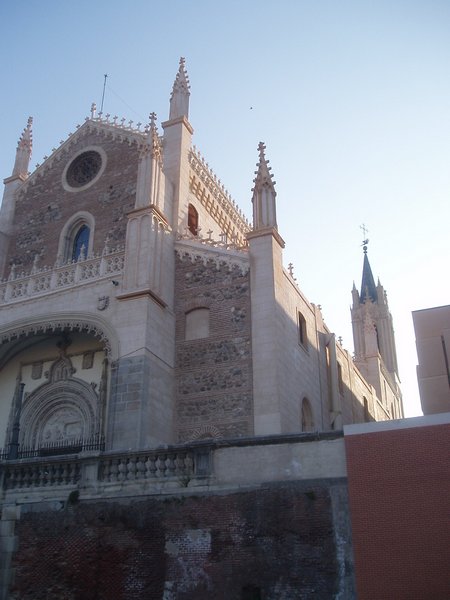
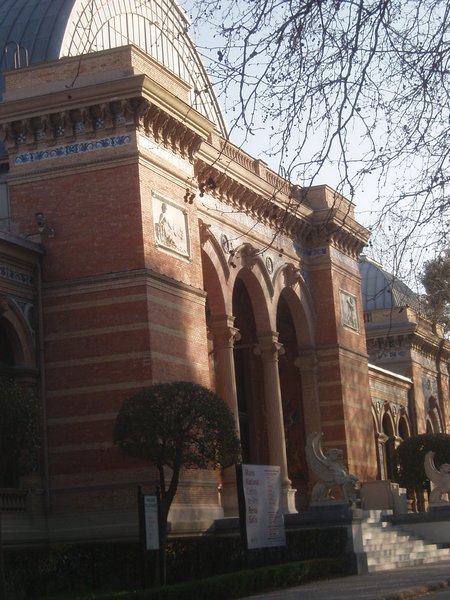
Palace in Buen Retiro Park
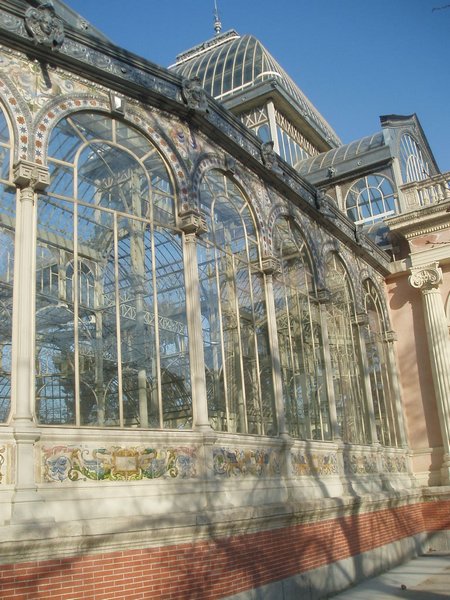
Another palace
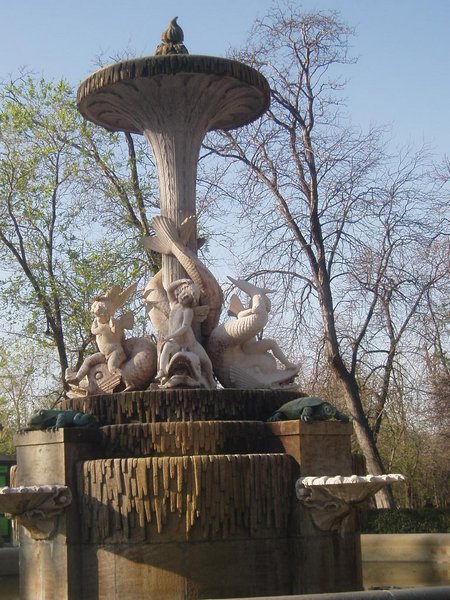

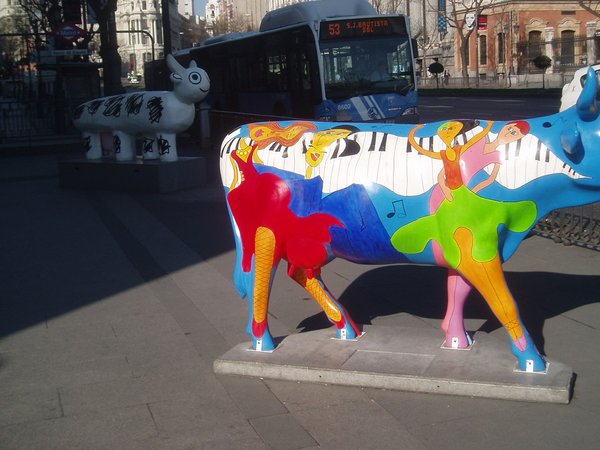
Normal cow and "kid cow"
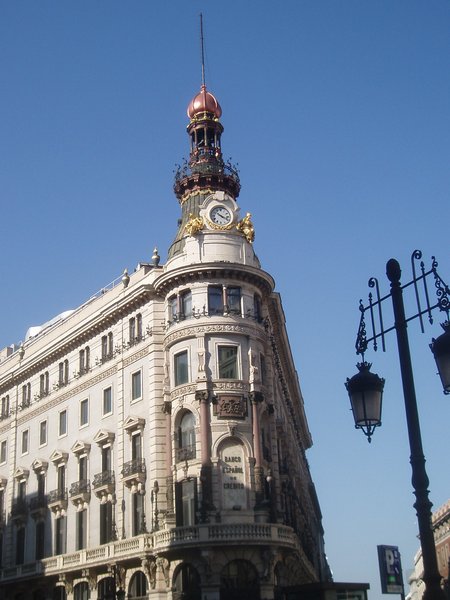
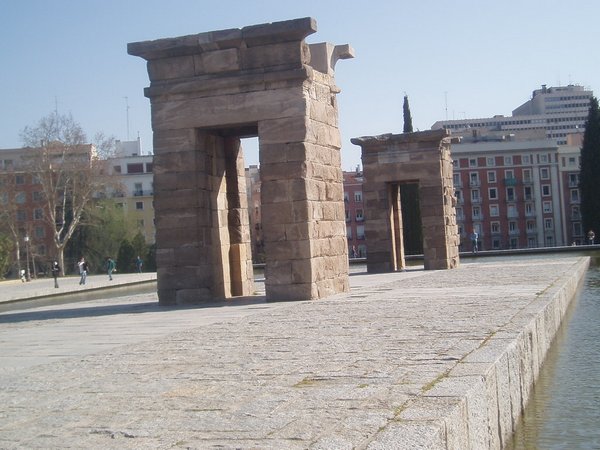
Egyptian temple
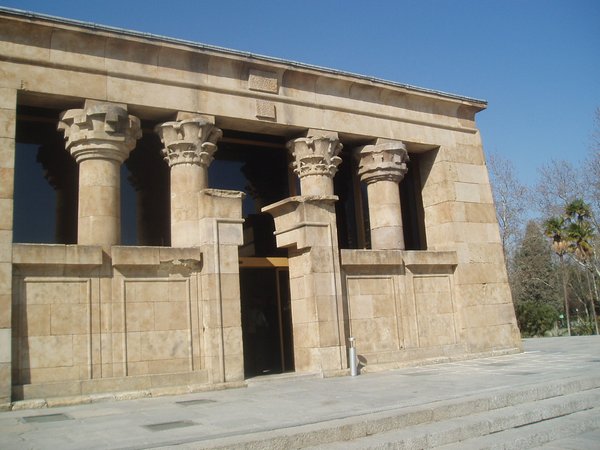
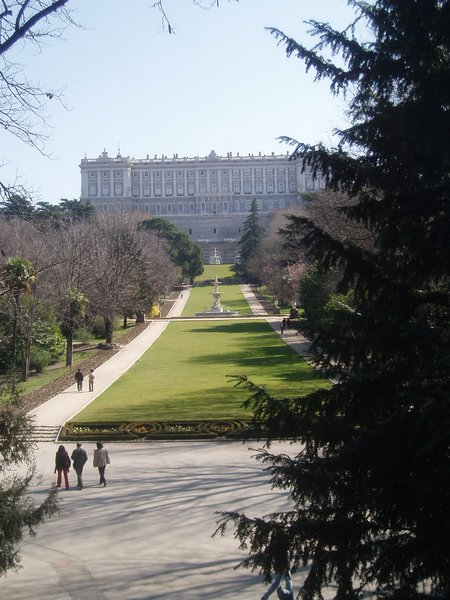


Spidey really needs to step up his web-slinging regimen a bit.
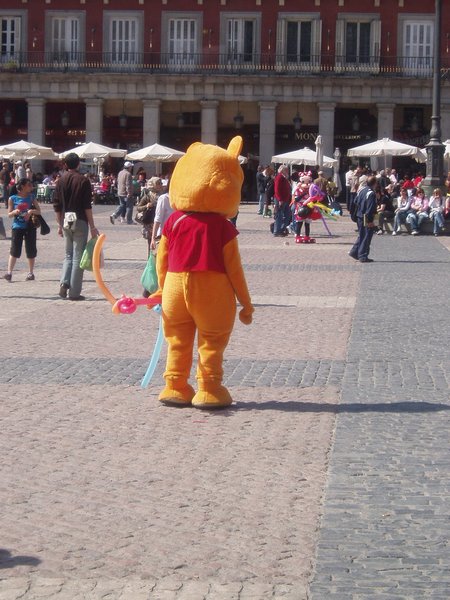
A rather dejected-looking Pooh
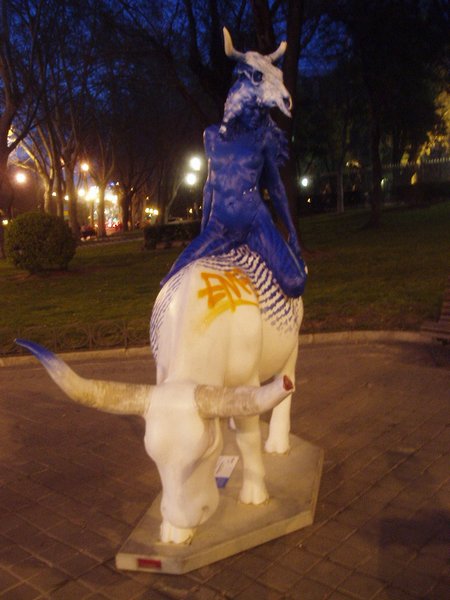
Naked blue woman riding bull with cow skull on head
With three flights and layovers, I would be in transit for a solid nineteen and a half hours; if all went according to plan, I would start my 8-mile bike ride home at nine that night and get in a full 10 hours before my 8:30am class. The trans-Atlantic flight was 8 hours long and I burned through my only book in the first third. The plane had no in-seat entertainment system and only showed one movie, which I had already seen, and a painful series of TV specials, including an E! Exclusive on Celine Dion. I was seated next to a member of the Lonnie Brooks Blues Band which was just returning from its latest tour through Spain.
I was frustrated that I had to go through security once again upon reaching Philadelphia - I tried to keep my money belt on through the detector, but found the US scanner to be more sensitive than its European counterparts - upon collecting my belongings, I made sure to check for camera, wallet, and passport, but completely forgot about the belt in a separate tray - I would not discover this until a minute before I boarded the plane to Charlotte, and spent the next few hours pondering how hard it would be to recover a clip with $100 and a credit card.
In Charlotte I found that I had somehow been assigned to Zone 9 for the boarding order. The other 53 passengers were in Zones 1 through 3, so I was the last one to come up for boarding by a 6 announcement margin. As I approached the gate, the attendant mentioned that they were still looking for someone to be bumped; I've never been a big fan of vouchers, but there was also the matter of the woman, standing immediately to one side of the desk, who only had eighteen hours to see her family before her next flight - I didn't want to bike through east Gainesville at night anyway.
I used the $10 food court voucher to get a sub and soup combo, and then ordered a shuttle to my free hotel. The Airport Wingate had free internet, a workout room, swimming pool, in-room coffee maker, four complementary shampoo bottles, and 100 channels of cable - I had never encountered such amenities in my travels before.
I woke up early and feasted on my complementary breakfast buffet. A free shuttle took me straight to the terminal and I was through security in 10 minutes. A light jet flew me and a handful of other passengers back to Gainesville. I biked the 8 miles home in the perfect North Florida springtime weather and began the arduous process of catching up on life.
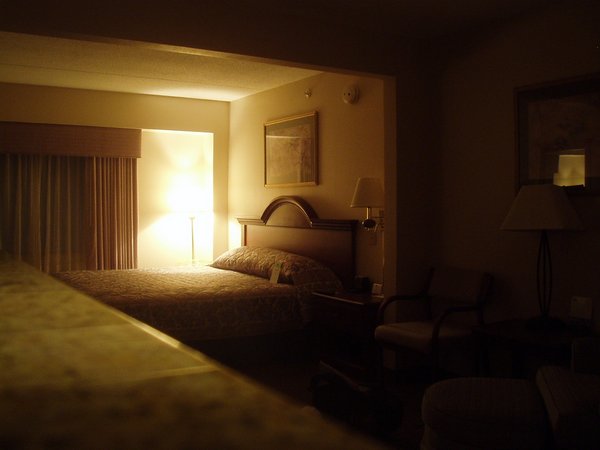
Free room in Charlotte - easily better than every other place I stayed at on this trip... combined.